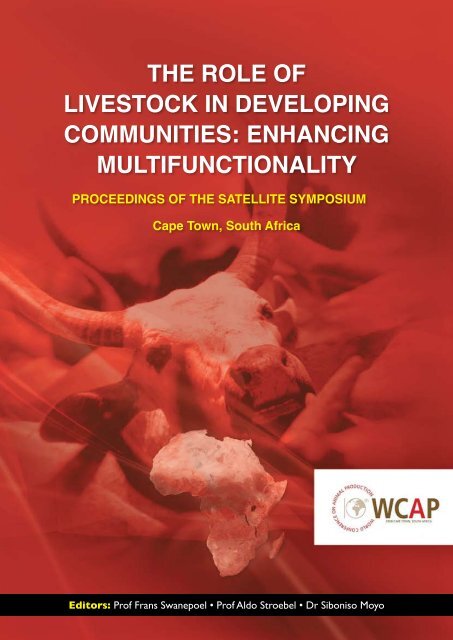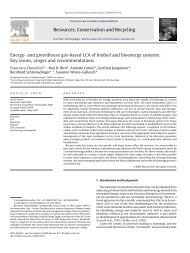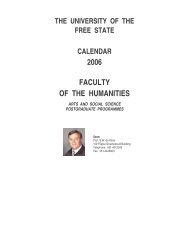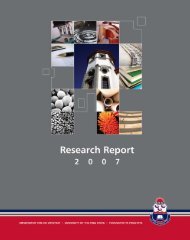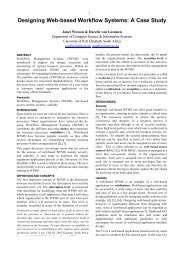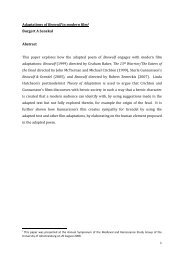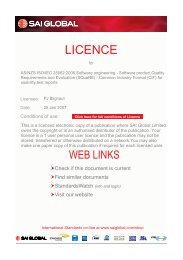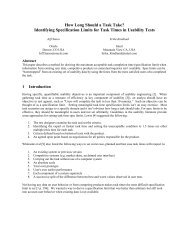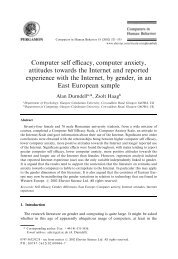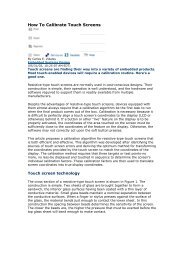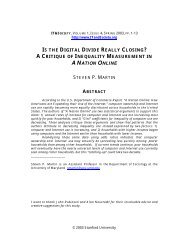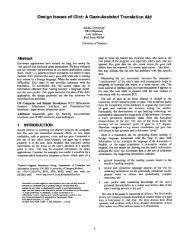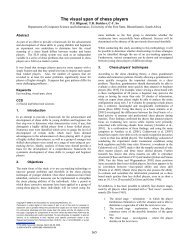the role of livestock in developing communities: enhancing ...
the role of livestock in developing communities: enhancing ...
the role of livestock in developing communities: enhancing ...
Create successful ePaper yourself
Turn your PDF publications into a flip-book with our unique Google optimized e-Paper software.
THE ROLE OF<br />
LIVESTOCK IN DEVELOPING<br />
COMMUNITIES: ENHANCING<br />
MULTIFUNCTIONALITY<br />
PROCEEDINGS OF THE SATELLITE SYMPOSIUM<br />
Cape Town, South Africa<br />
Editors: Pr<strong>of</strong> Frans Swanepoel • Pr<strong>of</strong> Aldo Stroebel • Dr Siboniso Moyo
Editors<br />
Pr<strong>of</strong> Frans Swanepoel: University <strong>of</strong> <strong>the</strong> Free State, South Africa<br />
Pr<strong>of</strong> Aldo Stroebel: University <strong>of</strong> <strong>the</strong> Free State, South Africa<br />
Dr Siboniso Moyo: ILRI, Mozambique<br />
Assisted by<br />
Pr<strong>of</strong> Johan van Rooyen: University <strong>of</strong> Pretoria ABSA Chair <strong>in</strong> AgriBus<strong>in</strong>ess Management, South Africa<br />
Lise Kriel: Researcher, Directorate Research Development, University <strong>of</strong> <strong>the</strong> Free State, South Africa<br />
Dr Canagasaby Devendra: Malaysia<br />
Pr<strong>of</strong> Piet Wilke: Emeritus Pr<strong>of</strong>essor, University <strong>of</strong> <strong>the</strong> Free State, South Africa<br />
Scientific Organis<strong>in</strong>g Committee<br />
Dr Siboniso Moyo: ILRI, Mozambique – Co-chairperson<br />
Pr<strong>of</strong> Frans Swanepoel: University <strong>of</strong> <strong>the</strong> Free State, South Africa – Co-chairperson<br />
Pr<strong>of</strong> Akke van der Zijpp: Wagen<strong>in</strong>gen University and Research Centre, The Ne<strong>the</strong>rlands<br />
Dr Canagasaby Devendra: Malaysia<br />
Pr<strong>of</strong> Aldo Stroebel: University <strong>of</strong> <strong>the</strong> Free State, South Africa<br />
Resource Team<br />
Sammy Carsan: ICRAF, Kenya & University <strong>of</strong> <strong>the</strong> Free State, South Africa<br />
Claud<strong>in</strong>e Macaskill: University <strong>of</strong> <strong>the</strong> Free State, South Africa<br />
Sponsorship<br />
International Livestock Research Institute (ILRI) <strong>of</strong> <strong>the</strong><br />
Consultative Group on International Agricultural Research (CGIAR)<br />
University <strong>of</strong> <strong>the</strong> Free State (UFS)<br />
Cornell University<br />
Australian Centre for International Agricultural Research (ACIAR)<br />
National Research Foundation (NRF)<br />
World Association <strong>of</strong> Animal Production (WAAP)
Table <strong>of</strong> Contents<br />
2<br />
Foreword<br />
3<br />
A short overview note: <strong>in</strong> search <strong>of</strong> a paradigm?<br />
7<br />
Discussion <strong>of</strong> Presentations<br />
8<br />
8<br />
8<br />
10<br />
10<br />
10<br />
11<br />
11<br />
13<br />
14<br />
14<br />
14<br />
16<br />
16<br />
16<br />
18<br />
18<br />
18<br />
Invited keynote<br />
What works, what doesn’t and why:<br />
development projects that make a difference<br />
Open discussion<br />
Panel discussion on cross-cutt<strong>in</strong>g <strong>the</strong>mes<br />
Promot<strong>in</strong>g gender equality and empower<strong>in</strong>g women through <strong>livestock</strong><br />
Livestock, livelihoods and <strong>the</strong> environment: f<strong>in</strong>d<strong>in</strong>g <strong>the</strong> balance<br />
Food, nutrition and health: its relevance <strong>in</strong> <strong>the</strong> develop<strong>in</strong>g world<br />
Facilitated discussion<br />
Syn<strong>the</strong>sis and conclusion<br />
Work<strong>in</strong>g group 1<br />
Vulnerability and risk: multiple <strong>role</strong>s <strong>of</strong> <strong>livestock</strong> <strong>in</strong> agrarian economies<br />
Rapporteur’s summary<br />
Work<strong>in</strong>g group 2<br />
Susta<strong>in</strong>able <strong>in</strong>tensification: wishful th<strong>in</strong>k<strong>in</strong>g or realistic prognosis?<br />
Rapporteur’s summary<br />
Work<strong>in</strong>g group 3<br />
Pathways from poverty through value cha<strong>in</strong>s and <strong>in</strong>novation<br />
Rapporteur’s summary<br />
20<br />
Symposium conclusion<br />
23<br />
Appendix 1:<br />
Authors, rapporteurs and facilitators contact list<br />
Proceed<strong>in</strong>gs <strong>of</strong> <strong>the</strong> Satellite Symposium: WCAP 1
Foreword<br />
This Proceed<strong>in</strong>gs is <strong>the</strong> product <strong>of</strong> a Satellite Symposium on <strong>the</strong> Role <strong>of</strong><br />
Livestock <strong>in</strong> Develop<strong>in</strong>g Communities: Enhanc<strong>in</strong>g Munltifunctionality held as<br />
part <strong>of</strong> <strong>the</strong> 10th World Conference on Animal Production <strong>in</strong> Cape Town, November<br />
2008.<br />
The Symposium, jo<strong>in</strong>tly organized by <strong>the</strong> University <strong>of</strong> <strong>the</strong> Free State (UFS)<br />
and <strong>the</strong> International Livestock Research Institute (ILRI) aimed to stimulate<br />
critical th<strong>in</strong>k<strong>in</strong>g on <strong>the</strong> <strong>role</strong> <strong>of</strong> <strong>livestock</strong> <strong>in</strong> livelihood strategies for <strong>the</strong> poor<br />
<strong>in</strong> <strong>the</strong> develop<strong>in</strong>g world as a contribution to address <strong>the</strong> Millennium Development<br />
Goals (MDGs). The <strong>livestock</strong> sector <strong>in</strong> develop<strong>in</strong>g countries contributes<br />
more than 33% to agricultural Gross Domestic Product (GDP), and is one <strong>of</strong><br />
<strong>the</strong> fastest grow<strong>in</strong>g agricultural sub-sectors.<br />
The <strong>livestock</strong> sector has been experienc<strong>in</strong>g what has been co<strong>in</strong>ed <strong>the</strong> “Livestock<br />
Revolution”. Population growth, urbanization, and most importantly,<br />
<strong>in</strong>creas<strong>in</strong>g <strong>in</strong>come have resulted <strong>in</strong> a rapid <strong>in</strong>crease <strong>in</strong> demand for <strong>livestock</strong><br />
products, which is likely to cont<strong>in</strong>ue well <strong>in</strong>to <strong>the</strong> future. This growth <strong>of</strong> <strong>the</strong><br />
<strong>livestock</strong> sector presents both enormous opportunities and challenges. This<br />
Proceed<strong>in</strong>gs <strong>the</strong>refore comes at an opportune time for both policy makers<br />
and practitioners <strong>in</strong> develop<strong>in</strong>g countries, and <strong>the</strong> <strong>in</strong>ternational community.<br />
Livestock is a major contributor to food and nutrition security, and serves as<br />
an important source <strong>of</strong> livelihood for nearly 1 billion poor people <strong>in</strong> develop<strong>in</strong>g<br />
countries. Its importance <strong>in</strong> atta<strong>in</strong><strong>in</strong>g <strong>the</strong> MDGs should <strong>the</strong>refore not be<br />
underestimated.<br />
This Proceed<strong>in</strong>gs will be supplemented by a forthcom<strong>in</strong>g book to be published<br />
soon. We are confident that <strong>the</strong> Proceed<strong>in</strong>gs toge<strong>the</strong>r with <strong>the</strong> book<br />
will assist <strong>in</strong> generat<strong>in</strong>g renewed <strong>in</strong>terest <strong>in</strong> <strong>the</strong> <strong>livestock</strong> sector. The book<br />
aims to provide critical <strong>in</strong>formation and knowledge on <strong>the</strong> importance <strong>of</strong><br />
<strong>livestock</strong> <strong>in</strong> <strong>the</strong> global effort to alleviate poverty and promote human health.<br />
It will describe and evaluate case studies, exam<strong>in</strong>e <strong>the</strong>oretical frameworks,<br />
and discuss key global policy development issues, challenges, and constra<strong>in</strong>ts<br />
related to smallholder <strong>livestock</strong> production systems around <strong>the</strong> globe. The<br />
book is written for academic pr<strong>of</strong>essionals, <strong>in</strong>dustry experts, government <strong>of</strong>ficials<br />
and o<strong>the</strong>r scholars <strong>in</strong>terested <strong>in</strong> <strong>the</strong> facts and issues concern<strong>in</strong>g <strong>the</strong><br />
contribution <strong>of</strong> <strong>livestock</strong> to <strong>the</strong> social and economic progress <strong>of</strong> develop<strong>in</strong>g<br />
countries.<br />
This publication conta<strong>in</strong>s <strong>the</strong> abstracts <strong>of</strong> <strong>the</strong> papers presented at <strong>the</strong> Satellite<br />
Symposium, supported by <strong>the</strong> discussions and concomitant analysis by <strong>the</strong><br />
facilitators, as well as <strong>the</strong> additional <strong>in</strong>formation provided by <strong>the</strong> rapporteurs.<br />
The presentations are available at www.ufs.ac.za/wcapsatellite<br />
The Editors would like to acknowledge, on behalf <strong>of</strong> <strong>the</strong> participants, <strong>the</strong> valuable<br />
support and contribution from <strong>the</strong> sponsors, as well as <strong>of</strong> <strong>the</strong> WCAP<br />
Organis<strong>in</strong>g Committee, <strong>in</strong> particular <strong>the</strong> Conference President, Pr<strong>of</strong> Norman<br />
Casey from <strong>the</strong> University <strong>of</strong> Pretoria, South Africa for <strong>the</strong> realisation <strong>of</strong> this<br />
Symposium.<br />
2<br />
Proceed<strong>in</strong>gs <strong>of</strong> <strong>the</strong> Satellite Symposium: WCAP
A short overview note: <strong>in</strong> search <strong>of</strong> a paradigm?<br />
Author: J van Rooyen<br />
Livestock systems are <strong>the</strong> largest land-use activity on earth (Herrero et al, p. 10), while global <strong>livestock</strong><br />
production is challenged to double by 2020. A central focus to this sector is to ensure that benefits – <strong>in</strong><br />
particular to small holders – are reaped from this ‘<strong>livestock</strong> revolution’ (Burrow, p. 18) <strong>in</strong> a ‘susta<strong>in</strong>able’<br />
manner and by do<strong>in</strong>g this, to give good effect to <strong>the</strong> ‘multifunctional’ nature <strong>of</strong> <strong>livestock</strong> <strong>in</strong> develop<strong>in</strong>g <strong>communities</strong>.<br />
Seventy percent <strong>of</strong> people liv<strong>in</strong>g <strong>in</strong> extreme poverty are located <strong>in</strong> rural areas <strong>of</strong> develop<strong>in</strong>g countries.<br />
Despite <strong>the</strong>ir production potential, small-scale rural producers (SPR’s) confront serious constra<strong>in</strong>ts<br />
<strong>in</strong> pr<strong>of</strong>it<strong>in</strong>g from <strong>the</strong>ir resources due to lack <strong>of</strong> basic <strong>in</strong>frastructure, limited access to services for production,<br />
f<strong>in</strong>ance and bus<strong>in</strong>ess development and limited ability to <strong>in</strong>fluence favourable policy. Toge<strong>the</strong>r with <strong>the</strong><br />
background paper, <strong>the</strong> keynote address provided an excellent focus to this symposium, sett<strong>in</strong>g out <strong>the</strong><br />
trends, issues and challenges concern<strong>in</strong>g <strong>the</strong> multifunctionality <strong>of</strong> <strong>livestock</strong> for develop<strong>in</strong>g <strong>communities</strong>.<br />
Various <strong>the</strong>mes focussed <strong>the</strong> proceed<strong>in</strong>gs <strong>of</strong> <strong>the</strong> satellite symposium. These <strong>in</strong>cluded aspects such as <strong>the</strong><br />
<strong>role</strong> <strong>of</strong> development projects; gender equality, power relationships, distributional issues and empowerment;<br />
<strong>livestock</strong> production and <strong>the</strong> environment; food, nutrition and health; risk factors; <strong>in</strong>tensification and access<br />
to supply cha<strong>in</strong>s; susta<strong>in</strong>ability; and poverty alleviation.<br />
Contributions all supported <strong>the</strong> notion that <strong>livestock</strong> production generally fulfils a multipurpose function<br />
<strong>in</strong> develop<strong>in</strong>g environments, rang<strong>in</strong>g from:<br />
• an economic perspective – <strong>livestock</strong> contribute to food supply and cash <strong>in</strong>come, to traction and<br />
fertiliser and to a valuable asset portfolio and <strong>in</strong>vestment opportunity;<br />
• a social viewpo<strong>in</strong>t – status, power relationships, gender balance and distribution <strong>of</strong> benefits are<br />
relevant when <strong>livestock</strong>’s contribution is analysed; In East Africa, where <strong>the</strong> private sector has not yet<br />
recognised <strong>the</strong> importance <strong>of</strong> research, <strong>in</strong>creased cooperation between <strong>the</strong> public and private sectors<br />
was necessary <strong>in</strong> <strong>the</strong> development <strong>of</strong> solutions. Not enough is known about knowledge transfer,<br />
<strong>in</strong>clud<strong>in</strong>g appropriate access, packag<strong>in</strong>g and delivery to different partners (eg. private sector, farmers<br />
and researchers). The real knowledge needs <strong>of</strong> different stakeholders must also be <strong>in</strong>vestigated, as also<br />
<strong>the</strong> different methods <strong>of</strong> knowledge acquisition used by <strong>the</strong>m;<br />
• <strong>the</strong> natural environment is <strong>in</strong>creas<strong>in</strong>gly relevant, because <strong>livestock</strong> owners are expected to fulfil an<br />
important stewardship <strong>role</strong> <strong>in</strong> ‘wise’ resource utilisation, while <strong>livestock</strong> production is <strong>of</strong>ten also<br />
considered as a ‘high-cost, natural resources <strong>in</strong>tensive’ food production system, requir<strong>in</strong>g energy <strong>in</strong>puts<br />
for both animal feed and human food production – a double energy dose <strong>the</strong>refore with ‘high carbon<br />
footpr<strong>in</strong>t’ implications. Environmental management systems (EMS) are methodical approaches to<br />
organis<strong>in</strong>g <strong>the</strong> plann<strong>in</strong>g, implementation and review <strong>of</strong> <strong>the</strong> impact on <strong>the</strong> environment us<strong>in</strong>g a “plan, act,<br />
monitor and review” cycle so called adaptive management.<br />
The many <strong>role</strong>s <strong>of</strong> <strong>livestock</strong> <strong>in</strong> develop<strong>in</strong>g <strong>communities</strong>, <strong>the</strong> issue <strong>of</strong> diversity and how to deal with it and<br />
possible conflicts <strong>in</strong> this context, clearly comes <strong>in</strong>to question – with this also <strong>the</strong> choices <strong>of</strong> <strong>in</strong>tervention<br />
mechanisms and appropriate development strategies. This all leads to a central question that must be considered<br />
critically <strong>in</strong> context <strong>of</strong> <strong>the</strong> topic <strong>of</strong> <strong>the</strong> symposium, viz, “does <strong>the</strong> current <strong>livestock</strong> development<br />
paradigm provide for <strong>the</strong> necessary understand<strong>in</strong>g and scope to enhance such diversity and multifunctionality<br />
<strong>in</strong> develop<strong>in</strong>g <strong>communities</strong>?” Research and development needs must orig<strong>in</strong>ate from <strong>the</strong> community,<br />
and community members must drive <strong>the</strong> research process. Researchers must be sensitive to this and<br />
develop <strong>the</strong> necessary skills to work with farmers.<br />
Multifunctionality must be considered as an important focus for <strong>the</strong> design <strong>of</strong> ‘development projects that<br />
can make a difference’. The keynote address by Pell et al explored ways how to <strong>in</strong>clude such considerations<br />
and various critical components were identified, <strong>in</strong> a systems context, to ensure that susta<strong>in</strong>ability is sufficiently<br />
considered. This paper, toge<strong>the</strong>r with various panel <strong>in</strong>puts on <strong>the</strong> relevant cross-cutt<strong>in</strong>g <strong>the</strong>mes<br />
and <strong>the</strong> work<strong>in</strong>g group contributions, <strong>in</strong>deed provided an <strong>in</strong>telligent framework to explore <strong>the</strong> validity <strong>of</strong><br />
<strong>the</strong> current paradigm. Some notable viewpo<strong>in</strong>ts from <strong>the</strong> symposium are referenced briefly:<br />
Proceed<strong>in</strong>gs <strong>of</strong> <strong>the</strong> Satellite Symposium: WCAP 3
Pell et al, p. 8: “Susta<strong>in</strong>able development, <strong>the</strong> goal <strong>of</strong> almost all poverty alleviation projects, is seldom<br />
achieved. Key to <strong>the</strong> success <strong>of</strong> this endeavour is refocus<strong>in</strong>g <strong>the</strong> mandates and efforts <strong>of</strong> <strong>in</strong>stitutions <strong>in</strong>volved<br />
<strong>in</strong> development to ensure that <strong>the</strong> development dialogue leads to <strong>in</strong>novative processes and reorder<strong>in</strong>g<br />
<strong>of</strong> priorities.” Whose priorities and how do we achieve successful implementation <strong>of</strong> <strong>the</strong>se useful<br />
ideas?<br />
Waters-Bayer & Letty, p. 10: “Despite years <strong>of</strong> gender sensitisation ... <strong>the</strong> <strong>role</strong> <strong>of</strong> women <strong>in</strong> <strong>livestock</strong> production<br />
and <strong>in</strong> market<strong>in</strong>g <strong>of</strong> animals and <strong>the</strong>ir products cont<strong>in</strong>ues to be underestimated.” Why does this<br />
cont<strong>in</strong>ue? Are <strong>the</strong>re not sufficient <strong>in</strong>centives built <strong>in</strong>to support <strong>in</strong>terventions to activate <strong>the</strong> required<br />
change?<br />
Herrero et al, p. 10: “A balanced discussion <strong>of</strong> <strong>the</strong> beneficial and negative impacts <strong>of</strong> <strong>livestock</strong> on livelihoods<br />
and <strong>the</strong> environment ... is needed. F<strong>in</strong>d<strong>in</strong>g a balance is <strong>in</strong> understand<strong>in</strong>g where <strong>the</strong>se impacts occur.” Also<br />
which generations will benefit or pay <strong>the</strong> price? I.e. <strong>in</strong>ter-temporal considerations as well as <strong>in</strong>tra-temporal<br />
should also be considered.<br />
Facilitated discussion on cross-cutt<strong>in</strong>g <strong>the</strong>mes, p. 12: “The challenge <strong>of</strong> reduc<strong>in</strong>g <strong>the</strong> (negative) impact <strong>of</strong><br />
animal production on global warm<strong>in</strong>g ... has not yet received enough attention or fund<strong>in</strong>g.” Clearly an issue<br />
<strong>of</strong> concern and for <strong>the</strong> research and development agenda <strong>of</strong> national and <strong>in</strong> particular <strong>in</strong>ternational<br />
agencies.<br />
Oel<strong>of</strong>se et al, p 12: “The prevalence <strong>of</strong> malnutrition <strong>in</strong> <strong>the</strong> develop<strong>in</strong>g world rema<strong>in</strong>s high amid numerous<br />
<strong>in</strong>ternational and local efforts to alleviate this burden … <strong>in</strong> this quest <strong>the</strong> <strong>in</strong>terface between food, nutrition<br />
and health has become <strong>in</strong>creas<strong>in</strong>gly important.” Livestock products can make an important contribution<br />
at all levels and household types, but what <strong>in</strong>terventions to make – where and when – rema<strong>in</strong>s a major<br />
challenge.<br />
D’Haese et al, p. 14: “Keep<strong>in</strong>g <strong>livestock</strong> is … an important way for poor people to diversify <strong>the</strong>ir livelihoods.<br />
It is a way <strong>of</strong> ex-ante risk management, which is a deliberate household strategy to anticipate failures <strong>in</strong><br />
crop yields or o<strong>the</strong>r <strong>in</strong>come streams.” How can <strong>livestock</strong> <strong>in</strong>come be generated to be a susta<strong>in</strong>able <strong>in</strong>comegenerat<strong>in</strong>g<br />
activity to <strong>the</strong>se households?<br />
Van der Zijpp et al, p. 16: “Why does <strong>in</strong>creased demand (for <strong>livestock</strong> products) not easily transfer <strong>in</strong>to<br />
<strong>in</strong>centives for small farmers?” The understand<strong>in</strong>g <strong>of</strong> and mechanisms to <strong>of</strong>fset <strong>the</strong> risks faced by <strong>the</strong>se<br />
<strong>livestock</strong> holders and <strong>the</strong>ir household economies is required as an <strong>in</strong>tegral component <strong>of</strong> any project<br />
<strong>in</strong>tervention.<br />
Facilitated discussion on cross-cutt<strong>in</strong>g <strong>the</strong>mes, p. 12: “Most small-scale farmers fail to take up technologies<br />
… because <strong>the</strong>y do not have any economic <strong>in</strong>centive to do so … <strong>the</strong> challenge is not only to transfer, but<br />
to develop appropriate technologies to transfer.” Technologies that focus on <strong>the</strong> diverse needs <strong>of</strong> particular<br />
types <strong>of</strong> <strong>livestock</strong> farm<strong>in</strong>g situations are clearly required.<br />
From this and <strong>the</strong> many o<strong>the</strong>r, <strong>of</strong>ten pessimistic op<strong>in</strong>ions voiced dur<strong>in</strong>g <strong>the</strong> symposium, <strong>the</strong> need for a<br />
comprehensive reth<strong>in</strong>k <strong>of</strong> <strong>the</strong> current paradigm is compell<strong>in</strong>g – too many gaps; too much ambiguity; too<br />
many recorded failed efforts!<br />
To my th<strong>in</strong>k<strong>in</strong>g one set <strong>of</strong> considerations that was (arguably) omitted or underemphasised as a crosscutt<strong>in</strong>g<br />
<strong>the</strong>me, was that <strong>of</strong> an ‘<strong>in</strong>stitutional-economic’ perspective on <strong>the</strong> diverse <strong>role</strong>s and positions <strong>of</strong><br />
<strong>livestock</strong> <strong>in</strong> <strong>the</strong> livelihood function <strong>of</strong> develop<strong>in</strong>g <strong>communities</strong>. Without this knowledge, a paradigm which<br />
<strong>in</strong>cludes a development path trajectory to guide effective development support and project type <strong>in</strong>terventions,<br />
are not fully constructed yet for <strong>the</strong> develop<strong>in</strong>g <strong>livestock</strong> sector. To illustrate this view po<strong>in</strong>t, some<br />
aspects are briefly elaborated upon below.<br />
4<br />
Proceed<strong>in</strong>gs <strong>of</strong> <strong>the</strong> Satellite Symposium: WCAP
A household economics perspective and <strong>livestock</strong> development<br />
Poor rural households are cont<strong>in</strong>uously <strong>in</strong>volved <strong>in</strong> a struggle to make ends meet; food security and family<br />
livelihood expenses be<strong>in</strong>g some <strong>of</strong> <strong>the</strong> major priorities. Livestock production could play a vital <strong>role</strong> <strong>in</strong> this<br />
context: directly through food provision, for example meat, milk, eggs; and also <strong>in</strong>directly by streng<strong>the</strong>n<strong>in</strong>g<br />
<strong>the</strong> household-economy through <strong>the</strong> provision <strong>of</strong> draught power, organic fertiliser and fuel, hides, commercial<br />
sales <strong>of</strong> animals and animal products and also through occasional sales to meet particular community<br />
and household needs such as school fees, celebrations, funerals, marriages, etc. The real contribution <strong>of</strong><br />
many <strong>of</strong> <strong>the</strong>se <strong>livestock</strong> products are however generally not accurately valued by <strong>the</strong> monetary yardstick<br />
alone.<br />
In this context <strong>the</strong> design <strong>of</strong> <strong>livestock</strong> commercialisation projects should be considered carefully: both<br />
from a susta<strong>in</strong>able bus<strong>in</strong>ess view; and also <strong>in</strong> context <strong>of</strong> <strong>the</strong> wider set <strong>of</strong> parameters driv<strong>in</strong>g <strong>the</strong> household<br />
economic system. Market prices alone will seldom provide realistic project value <strong>in</strong>dicators. Opportunity<br />
costs, social cost- benefit analysis, shadow prices and hedonistic pric<strong>in</strong>g models should be considered to<br />
determ<strong>in</strong>e potential impacts <strong>of</strong> project <strong>in</strong>terventions <strong>in</strong> general and more particularly on <strong>the</strong> participat<strong>in</strong>g<br />
households and <strong>the</strong>ir real <strong>in</strong>centives to collaborate.<br />
An <strong>in</strong>itiative to enhance <strong>livestock</strong> production <strong>in</strong> develop<strong>in</strong>g <strong>communities</strong> could, for example, be to reduce<br />
<strong>in</strong>fant <strong>livestock</strong> mortality – a very high opportunity cost factor <strong>in</strong> cattle, sheep and goat farm<strong>in</strong>g. The impact<br />
on <strong>the</strong> various households <strong>in</strong> <strong>the</strong> target community may however differ considerably, with certa<strong>in</strong><br />
households <strong>in</strong> a better position to benefit directly by expand<strong>in</strong>g <strong>the</strong>ir herds, while o<strong>the</strong>rs are made worse<br />
<strong>of</strong>f due to <strong>in</strong>creased pressure on <strong>the</strong> common graz<strong>in</strong>g resources. Environmental impacts related to subsequent<br />
<strong>in</strong>creased numbers vis-à-vis graz<strong>in</strong>g rates and veldt types have to be considered. Market<strong>in</strong>g systems<br />
must also be <strong>in</strong>troduced to enable <strong>the</strong> commercialisation <strong>of</strong> <strong>the</strong> <strong>in</strong>creased <strong>of</strong>f-take. Distributional impacts,<br />
<strong>in</strong> particular on gender positions, should also be considered when such <strong>in</strong>terventions are designed/appraised/<br />
evaluated.<br />
The wider impact at community level must also be traced. If sound knowledge <strong>of</strong> <strong>the</strong> work<strong>in</strong>gs <strong>of</strong> <strong>the</strong><br />
applicable ‘<strong>livestock</strong> typology’ and <strong>the</strong> relationship with participat<strong>in</strong>g households exists, a development<br />
trajectory for <strong>the</strong>se different household types with<strong>in</strong> this broader typology can be considered. The l<strong>in</strong>kup<br />
between typology and household is thus important to plan successful project <strong>in</strong>terventions. The development<br />
<strong>of</strong> susta<strong>in</strong>ability <strong>in</strong>dicators for specifically assess<strong>in</strong>g <strong>the</strong> contribution <strong>of</strong> animal production to <strong>the</strong><br />
quality <strong>of</strong> life <strong>of</strong> <strong>communities</strong> needed to be <strong>in</strong>vestigated.<br />
Diversity, typologies and farm<strong>in</strong>g types<br />
In a recent study on <strong>the</strong> <strong>role</strong> <strong>of</strong> ‘small stock farm<strong>in</strong>g’ <strong>in</strong> <strong>the</strong> rural based Leliefonte<strong>in</strong> community <strong>in</strong> <strong>the</strong><br />
Nor<strong>the</strong>rn Cape prov<strong>in</strong>ce <strong>of</strong> South Africa, Salome Modiselle (2005), after liv<strong>in</strong>g <strong>in</strong> <strong>the</strong> community for a<br />
considerable time dur<strong>in</strong>g her research, concluded that diversity <strong>in</strong> <strong>the</strong> <strong>role</strong>s <strong>of</strong> <strong>livestock</strong> at <strong>the</strong> household<br />
level required <strong>the</strong> recognition <strong>of</strong> a range <strong>of</strong> farm<strong>in</strong>g types, <strong>in</strong> order to design realistic and more effective<br />
development <strong>in</strong>tervention strategies. The construction <strong>of</strong> a <strong>livestock</strong> farm<strong>in</strong>g typology, describ<strong>in</strong>g at least<br />
six different types <strong>of</strong> <strong>livestock</strong> farm<strong>in</strong>g/hold<strong>in</strong>g models <strong>in</strong> operation <strong>in</strong> <strong>the</strong> community and rang<strong>in</strong>g from<br />
susta<strong>in</strong>ed commercial production to ‘status herd<strong>in</strong>g’ and food security, was considered necessary <strong>in</strong> this<br />
community to give effect to <strong>the</strong> required support and developmental <strong>in</strong>terventions. This <strong>in</strong>stitutional <strong>in</strong>novation<br />
departed radically from a ‘Taylorian type’ extension strategy, where ‘one-fits-all’ technological<br />
solutions were favoured by <strong>the</strong> government extension agencies.<br />
A similar ‘typology development approach’ was proposed and implemented <strong>in</strong> <strong>the</strong> Eastern Cape wool<br />
growers project, where shear<strong>in</strong>g sheds were, as a result, successfully extended and converted <strong>in</strong>to <strong>livestock</strong><br />
community mobilis<strong>in</strong>g and support centres, with good effect, to cater for <strong>the</strong> multifunctional nature <strong>of</strong><br />
<strong>livestock</strong> production <strong>in</strong> <strong>the</strong> target <strong>communities</strong> (D’Haese et al, p. 14).<br />
Proceed<strong>in</strong>gs <strong>of</strong> <strong>the</strong> Satellite Symposium: WCAP 5
The ‘tragedy <strong>of</strong> <strong>the</strong> commons’?<br />
Graz<strong>in</strong>g <strong>of</strong> <strong>livestock</strong> <strong>in</strong> many rural areas are on communally owned lands. The “tragedy <strong>of</strong> <strong>the</strong> commons” is<br />
well known, with a generalised application to ‘open access’ communal graz<strong>in</strong>g resources, where ecologically<br />
determ<strong>in</strong>ed carry<strong>in</strong>g capacity rates are transgressed. This, it is argued, is because <strong>the</strong> marg<strong>in</strong>al cost <strong>of</strong> such<br />
‘over’ graz<strong>in</strong>g to <strong>the</strong> <strong>in</strong>dividual <strong>livestock</strong> owner on <strong>the</strong> commons does not fully reflect <strong>the</strong> marg<strong>in</strong>al cost to<br />
<strong>the</strong> community at large, result<strong>in</strong>g <strong>in</strong> susta<strong>in</strong>ed overgraz<strong>in</strong>g <strong>in</strong>centives.<br />
Reality, however, is less clear. In situations <strong>of</strong> strong social cohesion, where access to communal graz<strong>in</strong>g<br />
resources is managed, sound graz<strong>in</strong>g and <strong>livestock</strong> husbandry practices could be implemented, with good<br />
susta<strong>in</strong>able results. Livestock improvement schemes <strong>in</strong>troduced under such regimes succeeded <strong>in</strong> general<br />
and resulted <strong>in</strong> <strong>the</strong> evenly distributed improvement <strong>of</strong> participants’ livelihoods.<br />
In o<strong>the</strong>r cases however, uneven power relations could exploit unclear/unspecified/open type communal<br />
graz<strong>in</strong>g arrangements on <strong>the</strong> commons. This led to opportunistic behaviour and <strong>the</strong> skewed distribution<br />
<strong>of</strong> benefits to such ‘powerful elites’ <strong>in</strong> <strong>the</strong> community.<br />
In a study <strong>in</strong> <strong>the</strong> (now) Limpopo prov<strong>in</strong>ce <strong>of</strong> South Africa (V<strong>in</strong>k, 1986), where <strong>the</strong> highly skew <strong>livestock</strong><br />
ownership status and distribution <strong>of</strong> resultant benefits <strong>in</strong> communal graz<strong>in</strong>g areas was <strong>in</strong>vestigated, it was<br />
concluded that <strong>the</strong> “tragedy <strong>of</strong> <strong>the</strong> commons” existed, with ‘overgraz<strong>in</strong>g’ <strong>of</strong> <strong>the</strong> commons apparent over<br />
a broad base. This situation was found to be <strong>the</strong> direct result <strong>of</strong> <strong>the</strong> “tragedy <strong>of</strong> <strong>the</strong> chiefs and <strong>the</strong>ir cronies”,<br />
i.e. powerful groups which exploited <strong>the</strong> common graz<strong>in</strong>g resources, with ever <strong>in</strong>creas<strong>in</strong>g <strong>livestock</strong><br />
herds graz<strong>in</strong>g <strong>in</strong> an open access regime with no enforceable graz<strong>in</strong>g and animal husbandry management<br />
arrangements. This resulted <strong>in</strong> <strong>the</strong> susta<strong>in</strong>ed over exploitation <strong>of</strong> <strong>the</strong> natural resource base <strong>of</strong> <strong>the</strong> community,<br />
which rendered <strong>livestock</strong> improvement schemes environmentally unsusta<strong>in</strong>able, while also largely<br />
<strong>in</strong>equitable and beneficial to only a small, powerful m<strong>in</strong>ority.<br />
Understand<strong>in</strong>g <strong>in</strong>stitutional structure and <strong>the</strong> impact on economic decision-mak<strong>in</strong>g must be viewed as an<br />
important parameter <strong>in</strong> <strong>the</strong> design <strong>of</strong> <strong>livestock</strong> development <strong>in</strong>terventions. In addition, appropriate policy<br />
frameworks, supportive <strong>in</strong>stitutions and “relevant” science is required to ensure success (Stroebel, 2004;<br />
Nthakheni, 2007). Ensur<strong>in</strong>g <strong>the</strong> success <strong>of</strong> <strong>in</strong>dividual projects and susta<strong>in</strong>able development <strong>in</strong>volves a number<br />
<strong>of</strong> issues:<br />
• Clear mandates and efforts <strong>of</strong> <strong>in</strong>stitutions participat<strong>in</strong>g <strong>in</strong> <strong>the</strong> research and development (R&D)<br />
• Clear identification <strong>of</strong> <strong>the</strong> bio-physical environment, problems, needs and priorities<br />
• Ensur<strong>in</strong>g effective development dialogue and <strong>in</strong>novative processes between all partners and<br />
also <strong>communities</strong><br />
• Application <strong>of</strong> <strong>in</strong>terdiscipl<strong>in</strong>ary R&D and system perspectives<br />
• Measurement <strong>of</strong> progress and impacts, and<br />
• Striv<strong>in</strong>g cont<strong>in</strong>uously towards shared goals and susta<strong>in</strong>able development.<br />
The comprehensive review <strong>of</strong> <strong>the</strong> current “<strong>livestock</strong> <strong>in</strong> develop<strong>in</strong>g <strong>communities</strong>” paradigm is now required.<br />
This satellite symposium provided <strong>the</strong> opportunity for a unique knowledge network to share experiences<br />
and ideas on how to enhance multifunctionality <strong>in</strong> <strong>livestock</strong> development. The comprehensive understand<strong>in</strong>g<br />
<strong>of</strong> this concept must be viewed as one <strong>of</strong> <strong>the</strong> cornerstones to ‘build’ such a new paradigm and <strong>in</strong> do<strong>in</strong>g<br />
so, to provide <strong>the</strong> urgently needed <strong>in</strong>tellectual framework for deal<strong>in</strong>g with <strong>the</strong> many formidable challenges<br />
fac<strong>in</strong>g this important sector <strong>in</strong> most develop<strong>in</strong>g environments.<br />
6<br />
Proceed<strong>in</strong>gs <strong>of</strong> <strong>the</strong> Satellite Symposium: WCAP
Discussion<br />
<strong>of</strong> presentations<br />
Presentations are available at<br />
www.ufs.ac.za/wcapsatellite
Invited keynote<br />
What works, what doesn’t and why:<br />
Development projects that make a difference<br />
Authors: A N Pell (presenter), A Stroebel & P Kristjanson<br />
Abstract: “Susta<strong>in</strong>able development”, <strong>the</strong> goal <strong>of</strong> almost all poverty alleviation projects, is seldom achieved.<br />
There are many reasons for this failure: 1) assess<strong>in</strong>g <strong>the</strong> susta<strong>in</strong>ability <strong>of</strong> a project requires a longer time<br />
horizon than is feasible <strong>in</strong> most projects, 2) lack <strong>of</strong> clarity <strong>in</strong> what is meant by ei<strong>the</strong>r “susta<strong>in</strong>able” or<br />
“development”, 3) exclusion <strong>of</strong> people and <strong>in</strong>stitutions essential to address<strong>in</strong>g <strong>the</strong> problem, and 4) lack <strong>of</strong><br />
consideration <strong>of</strong> aspects <strong>of</strong> <strong>the</strong> problems necessary for comprehensive solutions and focus on factors that<br />
are unimportant. In this paper, we explore with case studies how to ensure that <strong>the</strong> critical components <strong>of</strong><br />
a system are identified and addressed and how <strong>the</strong> people whose lives should be affected by development<br />
programmes not only are <strong>in</strong>cluded but also are given decision-mak<strong>in</strong>g power. Key to <strong>the</strong> success <strong>of</strong> this<br />
endeavour is refocus<strong>in</strong>g <strong>the</strong> mandates and efforts <strong>of</strong> <strong>in</strong>stitutions <strong>in</strong>volved <strong>in</strong> development to ensure that<br />
<strong>the</strong> development dialogue leads to <strong>in</strong>novative processes and reorder<strong>in</strong>g <strong>of</strong> priorities. Our examples are<br />
drawn from <strong>livestock</strong> projects, but reflect a systems approach so that we consider issues from <strong>the</strong> local to<br />
<strong>the</strong> <strong>in</strong>ternational level and along <strong>the</strong> biophysical and socio-economic cont<strong>in</strong>uum.<br />
Open discussion<br />
1. The presenter encouraged participants to th<strong>in</strong>k outside conventional approaches.<br />
2. Bio-fuel crops clearly affect <strong>livestock</strong> production <strong>in</strong> all areas (i.e., both wet and dry).<br />
3. In East Africa, where <strong>the</strong> private sector has not yet recognised <strong>the</strong> importance <strong>of</strong> research, <strong>the</strong> challenge<br />
rema<strong>in</strong>s to ga<strong>in</strong> cooperation between <strong>the</strong> public and private sectors <strong>in</strong> <strong>the</strong> development <strong>of</strong> solutions.<br />
• The double challenge posed by <strong>the</strong> existence <strong>of</strong> a weak private sector and a weak public sector<br />
<strong>in</strong> many African countries is acknowledged. However, projects are <strong>in</strong>creas<strong>in</strong>gly streng<strong>the</strong>n<strong>in</strong>g<br />
cooperation between <strong>the</strong> two sectors (for example, <strong>the</strong> sale <strong>of</strong> small packages <strong>of</strong> fertiliser to<br />
small-scale farmers, as opposed to bulk sales which <strong>the</strong>se farmers cannot readily afford).<br />
• This rema<strong>in</strong>s a policy issue, which research must address.<br />
• Conversations between private and public sectors must be <strong>in</strong>itiated long before products/results<br />
are available. Lessons from ‘best practice’ <strong>in</strong> this public/private sector relationship must be<br />
<strong>in</strong>vestigated.<br />
4. Duplication <strong>of</strong> research on <strong>the</strong> same topic (i.e. waste <strong>of</strong> resources) must be replaced by <strong>the</strong> active<br />
exchange <strong>of</strong> <strong>in</strong>formation (<strong>in</strong>stead <strong>of</strong> parallel/similar research reach<strong>in</strong>g <strong>the</strong> same results/conclusions).<br />
• Information is now be<strong>in</strong>g published onl<strong>in</strong>e (e.g. on blogs), but not everybody can (or do) access this.<br />
• A central, accessible repository <strong>of</strong> all research and all researchers per topic is needed.<br />
• A mechanism which prevents <strong>the</strong> publication <strong>of</strong> many papers describ<strong>in</strong>g <strong>the</strong> same results is needed.<br />
5. Knowledge transfer seems absent <strong>in</strong> <strong>the</strong> presentation. The appropriate packag<strong>in</strong>g and delivery<br />
(accessibility) <strong>of</strong> knowledge to different partners (e.g. private sector vs farmer vs researcher) rema<strong>in</strong>s<br />
a challenge.<br />
• The real knowledge needs <strong>of</strong> different stakeholders (i.e. not ‘what we th<strong>in</strong>k <strong>the</strong>y need’) must be<br />
<strong>in</strong>vestigated, as well as <strong>the</strong> different methods <strong>of</strong> knowledge acquisition used by such stakeholders.<br />
8<br />
Proceed<strong>in</strong>gs <strong>of</strong> <strong>the</strong> Satellite Symposium: WCAP
6. Research and development needs must be derived from <strong>the</strong> community. Community members must<br />
become research facilities and must drive <strong>the</strong> research process (i.e. ‘put <strong>the</strong> community beh<strong>in</strong>d <strong>the</strong><br />
steer<strong>in</strong>g wheel’).<br />
• However, researchers do not necessarily have <strong>the</strong> skills required to do this. The challenge here is<br />
to discover how researchers can acquire <strong>the</strong>se skills.<br />
7. The presentation is applicable to both developed and develop<strong>in</strong>g countries, because similar farm<strong>in</strong>g<br />
transitions and similar knowledge needs exist <strong>in</strong> both worlds.<br />
8. The application <strong>of</strong> <strong>the</strong> ‘tree model’ expla<strong>in</strong>ed <strong>in</strong> <strong>the</strong> presentation <strong>in</strong> different learn<strong>in</strong>g <strong>communities</strong><br />
(<strong>in</strong> both <strong>in</strong> developed and develop<strong>in</strong>g countries) may be challeng<strong>in</strong>g, especially where colleagues are<br />
more discipl<strong>in</strong>e-oriented and/or less familiar/comfortable with <strong>the</strong> use <strong>of</strong> systems approaches.<br />
• One solution is to help students with separate discipl<strong>in</strong>ary perspectives (i.e. with little <strong>in</strong> common)<br />
to work and learn toge<strong>the</strong>r <strong>in</strong> groups. This provides excellent <strong>in</strong>terdiscipl<strong>in</strong>ary tra<strong>in</strong><strong>in</strong>g and<br />
students who have conversations learn from each o<strong>the</strong>r <strong>in</strong> a way that <strong>the</strong>y would not have o<strong>the</strong>rwise.<br />
• Ano<strong>the</strong>r solution id to constitute multidiscipl<strong>in</strong>ary study-lead<strong>in</strong>g teams (committees) to advise<br />
students (<strong>in</strong>stead <strong>of</strong> s<strong>in</strong>gle supervisors, or a group from with<strong>in</strong> a s<strong>in</strong>gle discipl<strong>in</strong>e).<br />
9. Susta<strong>in</strong>ability is threatened when <strong>the</strong> objectives <strong>of</strong> different stakeholders (researchers, funders,<br />
community members, public and private sector organisations etc.) are not aligned. The challenge is to<br />
facilitate a shared goal among partners, to enable susta<strong>in</strong>ability.<br />
• This aspect is also affected by <strong>the</strong> short-term fund<strong>in</strong>g <strong>of</strong> projects with long-term goals.<br />
10. Ensur<strong>in</strong>g relevant decision-mak<strong>in</strong>g (by identify<strong>in</strong>g and appropriately <strong>in</strong>form<strong>in</strong>g <strong>the</strong> ‘decision-makers’)<br />
is a fur<strong>the</strong>r challenge.<br />
11. Even though understand<strong>in</strong>g <strong>the</strong> needs, aspirations, knowledge and requirements <strong>of</strong> a target group (be it<br />
<strong>the</strong> farmer or policy-maker) takes a lot <strong>of</strong> time and effort, it rema<strong>in</strong>s critically important to research.<br />
12. Community members should not only be <strong>in</strong>cluded <strong>in</strong> problem identification. There <strong>in</strong>digenous<br />
knowledge should also be actively utilised <strong>in</strong> identify<strong>in</strong>g solutions. i.e. <strong>in</strong>stead <strong>of</strong> driv<strong>in</strong>g new<br />
technologies, first try to identify local technologies to solve local problems.<br />
13. Susta<strong>in</strong>ability is cont<strong>in</strong>u<strong>in</strong>g development. Grassroots problems must be addressed through cont<strong>in</strong>u<strong>in</strong>g<br />
development <strong>of</strong> <strong>the</strong> community’s ability to study <strong>the</strong>ir own problems and to assist each o<strong>the</strong>r.<br />
• The development <strong>of</strong> susta<strong>in</strong>ability <strong>in</strong>dicators for specifically <strong>the</strong> contribution <strong>of</strong> animal production<br />
to <strong>the</strong> quality <strong>of</strong> life <strong>of</strong> <strong>communities</strong> must be <strong>in</strong>vestigated.<br />
14. In terms <strong>of</strong> <strong>the</strong> noted challenges and solutions, we must consider who benefits with<strong>in</strong> this development<br />
community (i.e. <strong>the</strong> researcher, <strong>the</strong> farmer, <strong>the</strong> animal or <strong>the</strong> funder). This begs <strong>the</strong> question: who holds<br />
<strong>the</strong> power, and do <strong>the</strong>y ma<strong>in</strong>ta<strong>in</strong> an altruistic attitude or a capitalist attitude?<br />
Proceed<strong>in</strong>gs <strong>of</strong> <strong>the</strong> Satellite Symposium: WCAP 9
Panel discussion on<br />
cross-cutt<strong>in</strong>g <strong>the</strong>mes<br />
Promot<strong>in</strong>g gender equality and<br />
empower<strong>in</strong>g women through <strong>livestock</strong><br />
Authors: A Waters-Bayer (presenter) & B Letty<br />
Abstract: Despite years <strong>of</strong> gender sensitisation <strong>in</strong> many research and extension organisations, <strong>the</strong> <strong>role</strong><br />
<strong>of</strong> women <strong>in</strong> <strong>livestock</strong> production and <strong>in</strong> market<strong>in</strong>g <strong>of</strong> animals and <strong>the</strong>ir products cont<strong>in</strong>ues to be underestimated.<br />
Some encourag<strong>in</strong>g projects do focus on women <strong>livestock</strong>-keepers, but most projects still tend<br />
to assume that <strong>the</strong> major actors <strong>in</strong> <strong>livestock</strong> (especially rum<strong>in</strong>ant) systems are men. By mak<strong>in</strong>g this assumption,<br />
such projects <strong>of</strong>ten streng<strong>the</strong>n <strong>the</strong> position <strong>of</strong> men versus women <strong>in</strong> households and <strong>communities</strong>,<br />
and may even deprive women <strong>of</strong> traditional realms <strong>of</strong> responsibility, social recognition and <strong>in</strong>come.<br />
We exam<strong>in</strong>e key issues that impact on gender equality when <strong>livestock</strong>-related <strong>in</strong>terventions are made <strong>in</strong><br />
<strong>the</strong> name <strong>of</strong> development – issues related to <strong>role</strong>s and responsibilities (both perceived and real), rights <strong>of</strong><br />
ownership over <strong>livestock</strong>, access to <strong>livestock</strong> services and markets, and decision-mak<strong>in</strong>g powers regard<strong>in</strong>g<br />
<strong>in</strong>puts and outputs <strong>of</strong> <strong>livestock</strong> production and result<strong>in</strong>g <strong>in</strong>come. We highlight <strong>in</strong>itiatives that lead to<br />
greater equality between <strong>the</strong> genders. These entail various forms <strong>of</strong> empower<strong>in</strong>g women, such as through<br />
recognis<strong>in</strong>g and stimulat<strong>in</strong>g <strong>the</strong>ir <strong>in</strong>novativeness <strong>in</strong> <strong>livestock</strong>-keep<strong>in</strong>g and enhanc<strong>in</strong>g <strong>the</strong>ir ability to organise<br />
<strong>the</strong>mselves so as to streng<strong>the</strong>n <strong>the</strong>ir negotiat<strong>in</strong>g position and access to benefits. We pay particular attention<br />
to <strong>the</strong> multifunctional and chang<strong>in</strong>g <strong>role</strong>s <strong>of</strong> <strong>livestock</strong> at household level, especially <strong>in</strong> improv<strong>in</strong>g <strong>the</strong><br />
lives <strong>of</strong> women <strong>in</strong> marg<strong>in</strong>alised groups, such as pastoralists, <strong>the</strong> rural and urban poor and families affected<br />
by HIV/AIDS.<br />
Livestock, livelihoods and <strong>the</strong> environment:<br />
F<strong>in</strong>d<strong>in</strong>g <strong>the</strong> balance<br />
Authors: M Herrero, P Gerber, P Lecomte, A Ayantunde,<br />
A J van der Zijpp (presenter), A Notenbaert, J van de Steeg & P K Thornton<br />
Abstract: Livestock play diverse <strong>role</strong>s <strong>in</strong> <strong>the</strong> livelihoods <strong>of</strong> people around <strong>the</strong> world. They are important<br />
providers <strong>of</strong> food for urban and rural consumers and <strong>the</strong>y are an important source <strong>of</strong> <strong>in</strong>come, employment<br />
and traction, especially for large numbers <strong>of</strong> poor people <strong>in</strong> <strong>the</strong> develop<strong>in</strong>g world. Livestock systems are<br />
<strong>the</strong> largest land use system on Earth and are organised <strong>in</strong> a varied array <strong>of</strong> production systems differ<strong>in</strong>g <strong>in</strong><br />
<strong>in</strong>tensification level. Livestock can consume substantial amounts <strong>of</strong> natural resources (i.e. land, water, feed,<br />
energy) <strong>in</strong> <strong>the</strong> process <strong>of</strong> meet<strong>in</strong>g <strong>the</strong> <strong>in</strong>creas<strong>in</strong>g demand for <strong>livestock</strong> products by <strong>the</strong> grow<strong>in</strong>g and more<br />
affluent human population. Some systems can also emit significant amounts <strong>of</strong> greenhouse gases.<br />
However, <strong>livestock</strong> are not bad everywhere. There are places where <strong>livestock</strong> can lead to severe environmental<br />
degradation (i.e. land conversion, nutrient load<strong>in</strong>g) or where <strong>livestock</strong> can be an <strong>in</strong>efficient way <strong>of</strong><br />
utilis<strong>in</strong>g exist<strong>in</strong>g natural resources. However, <strong>in</strong> o<strong>the</strong>r parts, <strong>the</strong> positive <strong>role</strong>s <strong>of</strong> <strong>livestock</strong> <strong>in</strong> <strong>the</strong> livelihoods<br />
<strong>of</strong> poor people outweigh <strong>the</strong> environmental problems caused <strong>in</strong> many regions <strong>of</strong> <strong>the</strong> world, especially <strong>in</strong><br />
marg<strong>in</strong>al areas where alternative livelihood options do not exist. This paper tries to provide a balanced<br />
discussion <strong>of</strong> <strong>the</strong> beneficial and negative impacts <strong>of</strong> <strong>livestock</strong> on livelihoods and <strong>the</strong> environment. It also<br />
argues that a large part <strong>of</strong> f<strong>in</strong>d<strong>in</strong>g a balance is <strong>in</strong> understand<strong>in</strong>g where <strong>the</strong>se impacts occur. This is crucial<br />
for design<strong>in</strong>g a coherent <strong>livestock</strong> research and development agenda for provid<strong>in</strong>g food, livelihood options<br />
and ma<strong>in</strong>ta<strong>in</strong><strong>in</strong>g ecosystems services around <strong>the</strong> world.<br />
10<br />
Proceed<strong>in</strong>gs <strong>of</strong> <strong>the</strong> Satellite Symposium: WCAP
Food, nutrition and health:<br />
Its relevance <strong>in</strong> <strong>the</strong> develop<strong>in</strong>g world<br />
Authors: A Oel<strong>of</strong>se (presenter), A M<strong>in</strong>naar & G Gericke<br />
Abstract: The prevalence <strong>of</strong> malnutrition <strong>in</strong> <strong>the</strong> develop<strong>in</strong>g world rema<strong>in</strong>s high amidst numerous <strong>in</strong>ternational<br />
and local efforts to alleviate this burden. Probably <strong>the</strong> most important <strong>of</strong> <strong>the</strong>se are <strong>the</strong> Millennium<br />
Development Goals (MDG). To achieve <strong>the</strong>se goals an array <strong>of</strong> projects across <strong>the</strong> develop<strong>in</strong>g nations are<br />
undertaken. In this quest <strong>the</strong> <strong>in</strong>terface between food, nutrition and health has become <strong>in</strong>creas<strong>in</strong>gly important.<br />
The study <strong>of</strong> food, its importance to provide essential nutrients and its subsequent impact on health<br />
has been receiv<strong>in</strong>g <strong>in</strong>creas<strong>in</strong>g attention as opposed to <strong>the</strong> different discipl<strong>in</strong>es <strong>in</strong> isolation. Many studies<br />
have been conducted focuss<strong>in</strong>g on s<strong>in</strong>gle nutrients and its potential to improve nutritional status and<br />
health. However, <strong>the</strong> concept <strong>of</strong> whole food and its collective contribution to <strong>the</strong> nutritional and health<br />
needs <strong>of</strong> especially <strong>communities</strong> from <strong>the</strong> develop<strong>in</strong>g world has become <strong>in</strong>creas<strong>in</strong>gly important. In addition<br />
<strong>the</strong> assessment <strong>of</strong> health benefit has become <strong>the</strong> norm to assist policy makers <strong>in</strong> decision mak<strong>in</strong>g regard<strong>in</strong>g<br />
national and <strong>in</strong>ternational food and nutrition policy.<br />
Food and nutrition for improved health and well be<strong>in</strong>g <strong>in</strong> develop<strong>in</strong>g populations poses much different and<br />
<strong>of</strong>ten more difficult challenges than <strong>in</strong> a developed sett<strong>in</strong>g. In <strong>the</strong>se populations food needs to provide very<br />
basic though essential nutrition to marg<strong>in</strong>alised populations to address micronutrient (Vit. A, iron, iod<strong>in</strong>e<br />
and z<strong>in</strong>c), but <strong>of</strong>ten also prote<strong>in</strong> and energy needs. This as well as <strong>the</strong> monitor<strong>in</strong>g and assessment <strong>of</strong> health<br />
benefit needs to be done <strong>in</strong> <strong>the</strong> face <strong>of</strong> many challenges <strong>in</strong> <strong>the</strong> delivery <strong>of</strong> both food and nutrients Some <strong>of</strong><br />
<strong>the</strong>se challenges <strong>in</strong>clude <strong>the</strong> co-existence <strong>of</strong> obesity and chronic disease e.g. hypertension as well as <strong>in</strong>fectious<br />
diseases like TB and HIV/AIDS. These circumstances are <strong>of</strong>ten exacerbated by civil war and unrest.<br />
The paper will look at <strong>the</strong> <strong>role</strong> <strong>of</strong> food <strong>in</strong> provid<strong>in</strong>g essential nutrients to develop<strong>in</strong>g <strong>communities</strong> to address<br />
nutrition and health needs <strong>of</strong> <strong>the</strong>se populations. It will also look at ways <strong>of</strong> address<strong>in</strong>g <strong>the</strong>se deficiencies<br />
through different strategies and <strong>the</strong> potential health benefit it may hold.<br />
Facilitated discussion<br />
Facilitator: E Nesamvuni<br />
1. L<strong>in</strong>k<strong>in</strong>g gender issues with small-stock production provides real pathways out <strong>of</strong> poverty.<br />
• The focus should be on women and <strong>the</strong>ir animals (small-stock, e.g. goats and poultry). These women<br />
small-stock farmers <strong>of</strong>ten want to move to larger animals; improv<strong>in</strong>g small-stock usage will<br />
<strong>the</strong>refore lead to larger stock usage.<br />
• Poultry is particularly relevant, s<strong>in</strong>ce it is available everywhere. Many women <strong>in</strong> Ethiopia are<br />
dependent upon poultry and <strong>the</strong>y utilise communal/shared ownership management systems.<br />
• The challenge rema<strong>in</strong>s as to how to move this type <strong>of</strong> farm<strong>in</strong>g forward for women.<br />
2. There does not seem to be any research underway <strong>in</strong>to payment for eco-services and <strong>in</strong>to <strong>the</strong> costs<br />
<strong>of</strong> this for different (developed/develop<strong>in</strong>g) countries.<br />
• Research should establish/document who is benefit<strong>in</strong>g from <strong>the</strong>se payments through case studies <strong>in</strong><br />
different countries and different situations (e.g. water harvest<strong>in</strong>g; <strong>in</strong>creas<strong>in</strong>g biodiversity).<br />
• Bureaucracy and corruption rema<strong>in</strong>s a challenge.<br />
3. Nutrition rema<strong>in</strong>s a challenge. Markets (consumers) dictate what farmers produce, and it is unreasonable<br />
to expect farmers to teach consumers about healthy eat<strong>in</strong>g habits. This should be <strong>the</strong> <strong>role</strong> <strong>of</strong> <strong>the</strong><br />
government.<br />
Proceed<strong>in</strong>gs <strong>of</strong> <strong>the</strong> Satellite Symposium: WCAP 11
• This is very true from <strong>the</strong> perspective <strong>of</strong> <strong>the</strong> commercial farmer (i.e. production is driven by<br />
consumer demand). However, rural farmers are <strong>of</strong>ten community leaders and <strong>the</strong>refore have some<br />
power to impact <strong>the</strong> health <strong>of</strong> <strong>the</strong>ir own <strong>communities</strong> through <strong>the</strong>ir food production choices.<br />
4. Some gaps rema<strong>in</strong> <strong>in</strong> <strong>the</strong> exist<strong>in</strong>g <strong>in</strong>novation studies on women and <strong>livestock</strong> (animal husbandry).<br />
• The ideas and creativity (<strong>in</strong>novations) <strong>of</strong> women must be better recognised. Work is needed to<br />
motivate researchers’ <strong>in</strong>terest <strong>in</strong> this area <strong>of</strong> study. Women’s <strong>in</strong>novations serve as an entry po<strong>in</strong>t<br />
(not a solution); <strong>the</strong> beg<strong>in</strong>n<strong>in</strong>g <strong>of</strong> show<strong>in</strong>g what farmers are do<strong>in</strong>g and can do.<br />
5. Small farmers are still <strong>in</strong>adequately equipped to move forward and to compete with large commercial<br />
farm<strong>in</strong>g. This rema<strong>in</strong>s an <strong>in</strong>equality issue (unequal access to knowledge, markets etc.). One solution<br />
could be for small farmers to work toge<strong>the</strong>r <strong>in</strong> co-operatives to <strong>in</strong>crease <strong>the</strong>ir power with<strong>in</strong> <strong>the</strong> <strong>in</strong>dustry.<br />
6. The challenge <strong>of</strong> reduc<strong>in</strong>g <strong>the</strong> impact <strong>of</strong> animal production on global warm<strong>in</strong>g (particularly <strong>in</strong><br />
develop<strong>in</strong>g countries) has not yet received enough attention or fund<strong>in</strong>g. Fur<strong>the</strong>r research is needed to<br />
develop methods for convert<strong>in</strong>g dung <strong>in</strong>to bio-gas and to reduce emission <strong>of</strong> gas from animal bodies.<br />
• Science has made a fair effort to reduce methane gas emissions.<br />
• Some countries utilise f<strong>in</strong>ancial <strong>in</strong>centive mechanisms to reduce methane production from rum<strong>in</strong>ants<br />
(e.g. south east Asian farmers are paid to produce bio-gas <strong>in</strong>stead <strong>of</strong> dump<strong>in</strong>g manure <strong>in</strong> rivers). The<br />
question is, however, if this <strong>in</strong>centive system is susta<strong>in</strong>able (i.e. where does <strong>the</strong> money come from<br />
and how long will it be available?).<br />
7. Researchers work<strong>in</strong>g on gender issues <strong>in</strong> agriculture must be cognisant <strong>of</strong> <strong>the</strong> fact that <strong>the</strong> empowerment<br />
<strong>of</strong> women <strong>in</strong> Africa must be accompanied by <strong>the</strong> empowerment <strong>of</strong> men. Disregard<strong>in</strong>g <strong>the</strong><br />
traditional customs <strong>of</strong> <strong>the</strong> people will lead to conflict with<strong>in</strong> <strong>the</strong> community.<br />
• This highlights that traditional customs (beliefs, traditions, ideology) are critical to development and<br />
success if rural projects, an issue which has not been given enough attention to date. Traditions must<br />
be understood <strong>in</strong> order to effect change.<br />
• Researchers with<strong>in</strong> <strong>the</strong> <strong>communities</strong> have <strong>in</strong>dicated that traditions are sometimes no longer<br />
practiced. The impact <strong>of</strong> this must be understood.<br />
• There are also situations where traditional customs work blatantly aga<strong>in</strong>st <strong>the</strong> wellbe<strong>in</strong>g <strong>of</strong> women,<br />
e.g. where women-headed households are not allowed (by tradition) to plough, These women must<br />
conv<strong>in</strong>ce a man to plough for <strong>the</strong>m and <strong>the</strong>n <strong>the</strong>y have to share <strong>the</strong>ir crops with him. Research is<br />
needed to <strong>in</strong>vestigate how such customs could be changed to allow s<strong>in</strong>gle women to farm<br />
<strong>in</strong>dependently and to feed <strong>the</strong>ir families.<br />
8. Most small-scale farmers fail to take up technologies developed by research, <strong>of</strong>ten because <strong>the</strong>y do not<br />
have any economic <strong>in</strong>centive to do so.<br />
• More conversation and <strong>in</strong>formation about technology transfer between researchers and farmers<br />
at community level is needed (s<strong>in</strong>ce many farmers can devise appropriate ways to address this<br />
challenge which researchers cannot).<br />
• The challenge is not only transfer, but development <strong>of</strong> appropriate technologies to transfer; i.e.<br />
technologies that suit <strong>in</strong>dividual/family contexts.<br />
9. Kenya has a large pastoral <strong>livestock</strong> system, but it rema<strong>in</strong>s challeng<strong>in</strong>g to engage women due to cultural<br />
and religious <strong>in</strong>hibitions (<strong>the</strong>y <strong>in</strong>clude women <strong>in</strong> meet<strong>in</strong>gs, but <strong>the</strong>y do not participate).<br />
• Sudan experiences similar challenges (where Sudanese women will not talk with non-Sudanese<br />
women). One solution is to hire educated Sudanese women to work <strong>in</strong> rural areas to develop <strong>the</strong><br />
confidence <strong>of</strong> rural women. With<strong>in</strong> 5 years <strong>the</strong> rural women were will<strong>in</strong>g to talk with both non-<br />
12<br />
Proceed<strong>in</strong>gs <strong>of</strong> <strong>the</strong> Satellite Symposium: WCAP
Sudanese women and men. This illustrates <strong>the</strong> successful use <strong>of</strong> an approach based on <strong>the</strong> rural<br />
women’s own contexts (‘own terms’).<br />
Syn<strong>the</strong>sis and conclusion<br />
Presenter: A Freeman<br />
The challenge<br />
• The MDG challenge<br />
- Contribution <strong>of</strong> <strong>livestock</strong> to social and economic progress <strong>in</strong> ways that do not have adverse<br />
impact on <strong>the</strong> environment<br />
• The complexity challenge - deal<strong>in</strong>g with complex systems and processes<br />
- Bus<strong>in</strong>ess as usual will not work<br />
- Not just what but how to address complicated development and environmental challenges …<br />
<strong>the</strong> big issues; research gaps<br />
Understand context and trade-<strong>of</strong>fs<br />
• Household asset situation<br />
- Resources (assets) and capabilities<br />
• Contexts where <strong>the</strong>y are us<strong>in</strong>g <strong>the</strong>ir assets<br />
- Bio-physical, environment, conflict<br />
- Delivery and support systems, <strong>in</strong>put and output markets<br />
- Research, extension<br />
- Policies and <strong>in</strong>stitutions<br />
• Understand decision mak<strong>in</strong>g processes<br />
- Complex trade-<strong>of</strong>fs<br />
- Income – nutrition<br />
- Gender differences<br />
- Environment-livelihood<br />
- GR technologies and micronutrients<br />
How: deal with complexity<br />
• Approaches, methods, and tools<br />
- Systems approaches, <strong>in</strong>ter-discipl<strong>in</strong>ary research and tra<strong>in</strong><strong>in</strong>g<br />
- Mixed methods – relevance; sett<strong>in</strong>g priorities,<br />
- Gender analysis – deal with gender differences and <strong>in</strong>equality<br />
- Life cycle analysis, <strong>in</strong>tegrated approaches to understand food-livelihood-health l<strong>in</strong>kages<br />
- GIS, spatial analysis – address system diversity<br />
How: do we know whe<strong>the</strong>r we are mak<strong>in</strong>g a difference<br />
• Measur<strong>in</strong>g outcomes and impact<br />
- Socio-economic<br />
- Bio-physical<br />
- Susta<strong>in</strong>ability<br />
Proceed<strong>in</strong>gs <strong>of</strong> <strong>the</strong> Satellite Symposium: WCAP 13
• Monitor<strong>in</strong>g and evaluation: processes and products<br />
- Learn what works, what does not work, why, under what context<br />
Processes are important<br />
• Not just what but why and how<br />
• Invest<strong>in</strong>g <strong>in</strong> front end analysis<br />
• Partnerships – research non-research<br />
• Inclusive and participatory<br />
Conclusions<br />
• Understand context<br />
• Target<strong>in</strong>g is important to deal with diversity and maximize impact<br />
• Learn from outcomes (what and magnitude <strong>of</strong> impact) and processes (why and how)<br />
• Inclusive, <strong>in</strong>terdiscipl<strong>in</strong>ary, <strong>in</strong>tegrated approaches<br />
Work<strong>in</strong>g group 1<br />
Vulnerability and risk: Multiple <strong>role</strong>s <strong>of</strong> <strong>livestock</strong><br />
<strong>in</strong> agrarian economies<br />
Authors: M D’Haese, S Speelman & L D'Haese (presenter)<br />
Abstract: Livestock is a key factor <strong>in</strong> African economies. Two case studies illustrate <strong>the</strong> ma<strong>in</strong> <strong>role</strong>s <strong>of</strong><br />
<strong>livestock</strong> keep<strong>in</strong>g <strong>in</strong> Africa: (a) a study <strong>in</strong> Burundi shows that households keep <strong>livestock</strong> as a management<br />
strategy to reduce vulnerability to risk <strong>of</strong> failure <strong>in</strong> future <strong>in</strong>come streams; and (b) a study <strong>in</strong> South Africa<br />
expla<strong>in</strong>s how collective action <strong>in</strong> a farmers’ association enables its members to keep sheep to generate<br />
additional <strong>in</strong>come. Burundi is one <strong>of</strong> <strong>the</strong> poorest countries <strong>in</strong> Africa. Data was collected <strong>in</strong> villages <strong>in</strong> two<br />
prov<strong>in</strong>ces. Results confirm that households depend on subsistence agriculture to cover <strong>the</strong>ir daily food<br />
needs. Investment <strong>in</strong> <strong>livestock</strong> and its management are limited.<br />
Keep<strong>in</strong>g <strong>livestock</strong> is identified to be an important way for people to diversify <strong>the</strong>ir livelihoods. It is a way<br />
<strong>of</strong> ex-ante risk management, which is a deliberate household strategy to anticipate failures <strong>in</strong> crop yields<br />
or o<strong>the</strong>r <strong>in</strong>come streams. The case <strong>of</strong> wool farmers’ associations <strong>in</strong> South Africa illustrates how <strong>livestock</strong><br />
keep<strong>in</strong>g contributes to village development. Data was collected <strong>in</strong> three villages <strong>in</strong> <strong>the</strong> former Transkei area<br />
among members and non-member <strong>of</strong> <strong>the</strong> association. For its members, wool production has become a<br />
susta<strong>in</strong>able <strong>in</strong>come generat<strong>in</strong>g activity. The farmers’ association is found to successfully create market access<br />
and enhance production. The collective action <strong>in</strong> <strong>the</strong> association reduces <strong>the</strong> vulnerability <strong>of</strong> <strong>in</strong>dividual<br />
farmers <strong>in</strong> market arrangements.<br />
Rapporteur’s summary<br />
Rapporteur: B Kruger<br />
Def<strong>in</strong>itions:<br />
• Risks: shocks that households have to deal with and can <strong>in</strong>clude environmental, socio-economic<br />
and political<br />
14<br />
Proceed<strong>in</strong>gs <strong>of</strong> <strong>the</strong> Satellite Symposium: WCAP
• Vulnerability: The ability/<strong>in</strong>ability <strong>of</strong> a household or community to cope with it.<br />
- Vulnerability is difficult to measure<br />
Question:<br />
• Can <strong>livestock</strong> play a <strong>role</strong> <strong>in</strong> improv<strong>in</strong>g poor people's ability to cope with risk and<br />
reduce <strong>the</strong>ir vulnerability?<br />
Two case studies:<br />
• Burundi<br />
- Subsistence oriented livelihoods<br />
- Households with <strong>livestock</strong> and cash cropp<strong>in</strong>g less vulnerable<br />
- Not everybody is <strong>the</strong> same and <strong>in</strong>-depth analysis and understand<strong>in</strong>g <strong>of</strong> household dynamics<br />
are needed before <strong>in</strong>terventions.<br />
- Low productivity levels <strong>of</strong> <strong>livestock</strong><br />
- Low uptake <strong>of</strong> technologies, e.g. veter<strong>in</strong>ary medic<strong>in</strong>es<br />
• South Africa<br />
- More commercially oriented enterprises<br />
- Risks:<br />
- Investment risks: land reform process; bureaucracy; uncerta<strong>in</strong>ty; dis<strong>in</strong>vestment<br />
- Supply Cha<strong>in</strong> risks: quality; quantity and cont<strong>in</strong>uity <strong>of</strong> production –<br />
post settlement support needed<br />
- Strategic partner risk: Lack <strong>of</strong> strategic partners<br />
Important issues<br />
• Women’s position <strong>in</strong> vulnerability<br />
• Livestock not only cattle – goats, sheep, poultry, etc.<br />
• Lack <strong>of</strong> security over land tenure: private ownership versus communal systems -<br />
“tragedy <strong>of</strong> <strong>the</strong> commons” vs. “tragedy <strong>of</strong> powerful people”<br />
• Lack <strong>of</strong> collateral without title deeds<br />
• Institution build<strong>in</strong>g <strong>in</strong> <strong>the</strong> <strong>communities</strong> needed (social capital)<br />
• Ma<strong>in</strong>ta<strong>in</strong><strong>in</strong>g flexibility and reciprocity <strong>in</strong> <strong>communities</strong><br />
• L<strong>in</strong>ks to markets to serve as <strong>in</strong>centives to <strong>in</strong>crease uptake <strong>of</strong> technologies<br />
• Role <strong>of</strong> “middle-men” <strong>in</strong> <strong>the</strong> market<strong>in</strong>g cha<strong>in</strong><br />
• Government policies tend to favour cattle over o<strong>the</strong>r <strong>livestock</strong><br />
• Shr<strong>in</strong>k<strong>in</strong>g availability <strong>of</strong> land for <strong>livestock</strong><br />
Proceed<strong>in</strong>gs <strong>of</strong> <strong>the</strong> Satellite Symposium: WCAP 15
Work<strong>in</strong>g group 2<br />
Susta<strong>in</strong>able <strong>in</strong>tensification: Wishful th<strong>in</strong>k<strong>in</strong>g or<br />
realistic prognosis?<br />
Authors: A J van der Zijpp & H M J Udo<br />
Abstract: The demand for <strong>livestock</strong> products is <strong>in</strong>creas<strong>in</strong>g as predicted by <strong>the</strong> Livestock Revolution.<br />
Susta<strong>in</strong>able <strong>in</strong>tensification has been <strong>the</strong> solution to decrease poverty <strong>of</strong> smallholder farmers and provide<br />
more food at acceptable prices for a grow<strong>in</strong>g population. Why does <strong>in</strong>creased demand not easily translate<br />
<strong>in</strong>to <strong>in</strong>centives for small farmers? The response <strong>of</strong> poor farmers depends on <strong>the</strong> household resources and<br />
<strong>the</strong> context <strong>of</strong> <strong>the</strong>ir farm<strong>in</strong>g system.<br />
The family situation, labour, land (fertility and water), feed and cash availability determ<strong>in</strong>e development.<br />
The context presents a wide range <strong>of</strong> issues: <strong>in</strong>frastructure and markets, services like extension, animal<br />
health, breed<strong>in</strong>g, microcredit, feed access and farmers associations. They effect <strong>the</strong> management options<br />
<strong>of</strong> <strong>the</strong> smallholder. These options may be fur<strong>the</strong>r effected by competition <strong>of</strong> smallholders, medium and<br />
large scale farmers and cheap imports. Poor farmers appreciate <strong>livestock</strong> as assets and for f<strong>in</strong>ancial <strong>in</strong>surance<br />
and food. Market participation requires <strong>in</strong>vestment and changes <strong>the</strong> asset and <strong>in</strong>surance function <strong>of</strong><br />
<strong>livestock</strong>. Livestock species vary <strong>in</strong> <strong>the</strong>ir contribution to <strong>in</strong>come, <strong>in</strong>vestment needs and gender association.<br />
To assist poor farmers to <strong>of</strong>fset <strong>the</strong> risks <strong>of</strong> market led production appropriate policies are needed l<strong>in</strong>k<strong>in</strong>g<br />
resources with local/regional and national contexts.<br />
Rapporteur’s summary<br />
Rapporteur: P Wilke<br />
Intensification to decrease poverty<br />
• Agricultural food production challenges: food reserves currently last for 50 days from 80 days a decade ago<br />
• Diversify <strong>livestock</strong> production: <strong>in</strong> Lesotho dairy production l<strong>in</strong>ked to school feed<strong>in</strong>g programmes;<br />
engage <strong>in</strong> sell<strong>in</strong>g different animal products<br />
• Farmer <strong>in</strong>novation is <strong>of</strong>ten led by <strong>in</strong>centives example: drip irrigation <strong>in</strong> Lesotho where farmers<br />
<strong>in</strong>novation is driven by attractive <strong>in</strong>come e.g. for marijuana, and ready market<br />
Issues on susta<strong>in</strong>ability<br />
Institutional arrangements<br />
• Processes that create work<strong>in</strong>g farmer <strong>in</strong>stitutions need be addressed<br />
• How to facilitate process for develop<strong>in</strong>g quality products and related <strong>in</strong>stitutional support rema<strong>in</strong>s a<br />
bottleneck<br />
• In many <strong>in</strong>stances farmers do not own value add<strong>in</strong>g facilities and are struggl<strong>in</strong>g to access <strong>the</strong>m.<br />
• Role <strong>of</strong> cooperatives need be enhanced so that benefits are accrued by members<br />
• Facilitation for exist<strong>in</strong>g and new farmer associations needed; farmers need to take lead <strong>in</strong> organiz<strong>in</strong>g<br />
for markets<br />
16<br />
Proceed<strong>in</strong>gs <strong>of</strong> <strong>the</strong> Satellite Symposium: WCAP
Farmer reward systems<br />
• Informal market<strong>in</strong>g for animal products is prevalent. There is need for better market<strong>in</strong>g especially<br />
with improvements on packag<strong>in</strong>g<br />
• Small animal production at household with a huge potential e.g. pig rear<strong>in</strong>g need be enhanced and<br />
supported by government<br />
• Government’s <strong>in</strong>centives needed to enhance management, market<strong>in</strong>g <strong>of</strong> animal products, and<br />
even for tourism<br />
- Moagi: (farmer from North West Prov<strong>in</strong>ce <strong>of</strong> South Africa) “If a cow give a farmer 20 litres, <strong>the</strong>re is<br />
product ‘flood<strong>in</strong>g’”. Government need to consider subsidies like <strong>in</strong> Europe and curb dump<strong>in</strong>g<br />
<strong>of</strong> products <strong>in</strong> Africa<br />
• Value cha<strong>in</strong> participation for smallholders is poor result<strong>in</strong>g <strong>in</strong> marg<strong>in</strong>al <strong>in</strong>comes for smallholders e.g.<br />
<strong>of</strong>ten researchers encourage production but not how to participate <strong>in</strong> <strong>the</strong> high end market segments<br />
- Example: Beef farmers get paid for animal carcass and not for o<strong>the</strong>r products (fourth quarter) which<br />
goes to abattoir operators<br />
- Women empowerment programmes need to <strong>in</strong>volve men to m<strong>in</strong>imize conflicts at household level<br />
Constra<strong>in</strong>ts <strong>of</strong> <strong>in</strong>tensification depend<strong>in</strong>g on context<br />
• Enhanced value cha<strong>in</strong> performance depends a farmer’s situation; we <strong>of</strong>ten assume farmers want more<br />
<strong>of</strong> <strong>the</strong> same enterprise- <strong>the</strong> value <strong>of</strong> diversity <strong>of</strong> enterprise need to be fur<strong>the</strong>r explored<br />
• Assess constra<strong>in</strong>ts <strong>of</strong> <strong>in</strong>tensification depends on <strong>the</strong> context e.g. when <strong>livestock</strong> faces challenges <strong>of</strong><br />
diseases, droughts, etc.<br />
• More efficient use <strong>of</strong> available resources is required<br />
Demand and supply issues<br />
• Government responsibilities and household resources are important. Are farmers produc<strong>in</strong>g more<br />
from <strong>the</strong> same resources or less?<br />
- Examples (David Muteti): <strong>in</strong> Uganda despite huge maize market <strong>in</strong> Sou<strong>the</strong>rn Sudan farmers cannot<br />
produce enough and prices have shot up and now Ugandans cannot afford maize; O<strong>the</strong>r examples:<br />
Goat and honey exports is overstretched.<br />
- On <strong>the</strong> o<strong>the</strong>r hand, <strong>of</strong>ten <strong>the</strong>re is overproduction <strong>of</strong> banana, milk and <strong>the</strong> market is reliant on<br />
outsiders. Government need to encourage commodity market<strong>in</strong>g with<strong>in</strong> <strong>communities</strong> ra<strong>the</strong>r than<br />
rely on outsiders.<br />
- Sometimes production is not <strong>in</strong> sufficient quantities to participate <strong>in</strong> markets effectively<br />
Infrastructure:<br />
• Impediment where government <strong>in</strong>vestment is low: road networks; abattoirs, refrigeration <strong>of</strong> vacc<strong>in</strong>es<br />
(e.g. <strong>in</strong> Uganda)<br />
• Also <strong>the</strong>re are cases where many farmers cannot access abattoirs (e.g. <strong>in</strong> Sudan) due to animal quality<br />
issues.<br />
• Animal production is also affected by:<br />
- Water access (milk is 80% water)<br />
- Electricity<br />
Proceed<strong>in</strong>gs <strong>of</strong> <strong>the</strong> Satellite Symposium: WCAP 17
Work<strong>in</strong>g group 3<br />
Pathways from poverty through<br />
value cha<strong>in</strong>s and <strong>in</strong>novation<br />
Author: H M Burrow (presenter)<br />
Abstract: Develop<strong>in</strong>g supply cha<strong>in</strong>s that deliver to specifications <strong>of</strong> new or exist<strong>in</strong>g markets <strong>of</strong>fers a way<br />
to ensure poor <strong>livestock</strong> farmers benefit from growth opportunities from <strong>the</strong> “Livestock Revolution”. To<br />
develop such supply cha<strong>in</strong>s, several research and <strong>in</strong>dustry development issues must be addressed: 1) Pro<strong>of</strong><br />
<strong>of</strong> concept that <strong>livestock</strong> raised by poor farmers can meet <strong>the</strong> requirements <strong>of</strong> commercial domestic or <strong>in</strong>ternational<br />
markets (to provide <strong>the</strong> confidence required by commercial <strong>in</strong>vestors); 2) Def<strong>in</strong>ition <strong>of</strong> production<br />
and market<strong>in</strong>g systems that can be targeted by <strong>the</strong> rural poor, ideally based on low <strong>in</strong>put production<br />
systems or where commercial enterprises accept partial risk and/or fund<strong>in</strong>g <strong>of</strong> higher <strong>in</strong>put production<br />
systems; 3) Capacity build<strong>in</strong>g <strong>of</strong> poor farmers focused on supply cha<strong>in</strong> requirements, <strong>in</strong>clud<strong>in</strong>g pr<strong>of</strong>itability<br />
and productivity and cont<strong>in</strong>uous improvement and <strong>in</strong>novation; 4) Capacity build<strong>in</strong>g <strong>of</strong> commercial supply<br />
cha<strong>in</strong> sectors so <strong>the</strong>y can best utilise <strong>livestock</strong> delivered by poor farmers; 5) New w<strong>in</strong>-w<strong>in</strong> partnerships<br />
established across two or more segments <strong>of</strong> <strong>the</strong> supply cha<strong>in</strong> (e.g. poor farmers and commercial feedlotters,<br />
processors and/or retailers); 6) Implementation <strong>of</strong> a value-based market<strong>in</strong>g system across supply cha<strong>in</strong><br />
segments, with value at each stage reflect<strong>in</strong>g <strong>the</strong> product’s ultimate value at consumer level; 7) Possible<br />
market segmentation based on consumer demand; and 8) Measurable and agreed performance <strong>in</strong>dicators<br />
across all sectors <strong>of</strong> <strong>the</strong> supply cha<strong>in</strong>. Each <strong>of</strong> <strong>the</strong>se issues will be discussed by example.<br />
Rapporteur’s summary<br />
Rapporteur: J McDermott<br />
Value Cha<strong>in</strong>s - Considerations<br />
ACTORS – who are <strong>the</strong>y, what do <strong>the</strong>y do, what capacity do <strong>the</strong>y need<br />
• Capacity build<strong>in</strong>g<br />
• Knowledge management, network<strong>in</strong>g, shar<strong>in</strong>g <strong>of</strong> <strong>in</strong>formation across different areas and sectors<br />
WHO BENEFITS AND HOW<br />
• Farmer’s <strong>in</strong>come that can be used for multiple purposes; better understand<strong>in</strong>g <strong>of</strong> <strong>the</strong>ir own<br />
enterprises and market demands (costs and budgets)<br />
• Buyers (understand<strong>in</strong>g buyer demands)<br />
• What are <strong>the</strong> returns from projects (is this <strong>the</strong> most cost-effective approach)?<br />
• Role <strong>of</strong> <strong>livestock</strong> (multi-functionality versus commercial specialization depend<strong>in</strong>g on <strong>the</strong> system)<br />
“GOVERNANCE” / MANAGEMENT – how are <strong>the</strong> value cha<strong>in</strong>s regulated and managed<br />
• Who decides on priorities (community choice)<br />
• Regulations/Policies that address risks and meet needs <strong>of</strong> different actors (enabl<strong>in</strong>g) – pig slaughter<strong>in</strong>g<br />
<strong>in</strong> Zimbabwe; <strong>in</strong>formal milk markets; Beef <strong>in</strong> SA – regulators brought <strong>in</strong>to discussion (bov<strong>in</strong>e measles)<br />
18<br />
Proceed<strong>in</strong>gs <strong>of</strong> <strong>the</strong> Satellite Symposium: WCAP
IMPROVEMENTS – along <strong>the</strong> value cha<strong>in</strong><br />
• Competitiveness/price<br />
• Niche (e.g. weaners versus mature animals)<br />
• Quality – taste/tenderness<br />
• Regular and sufficient supply<br />
• Reduc<strong>in</strong>g risks (forward contract<strong>in</strong>g)<br />
• Cutt<strong>in</strong>g costs – on-farm/community auctions<br />
INNOVATION SYSTEMS – functions / l<strong>in</strong>kages<br />
• Systematic approach and assessment tak<strong>in</strong>g <strong>in</strong>to account <strong>the</strong> context; monitor<strong>in</strong>g, evaluation<br />
(term <strong>of</strong> view - short, medium, long and how is this handled)<br />
• Consider new arrangements - partnerships with private sector or alternative <strong>in</strong>put supply<br />
systems identify<strong>in</strong>g new actors and how <strong>the</strong>y are l<strong>in</strong>ked to <strong>the</strong> system (land banks)<br />
• Test<strong>in</strong>g/Experimentation - Build capacity for decision mak<strong>in</strong>g, up-scal<strong>in</strong>g and out-scal<strong>in</strong>g (return<br />
(impact assessment) on <strong>in</strong>vestments from projects)<br />
Value Cha<strong>in</strong>s - Lessons<br />
DON’Ts – what should we stop / not repeat<br />
• Build a slaughterhouse away from <strong>the</strong> market<br />
• Sole focus on technical issues (<strong>the</strong>se will follow)<br />
• Conduct value cha<strong>in</strong> research and development which is not driven by <strong>the</strong> farmers’ <strong>in</strong>terests<br />
(ownership) - get farmers to negotiate on what will be <strong>the</strong> process<br />
• Try a new concept (dual purpose dairy goat) without consider<strong>in</strong>g local context<br />
(goat milk not demanded)<br />
DOs - what should we try aga<strong>in</strong> or adapt and improve upon<br />
• L<strong>in</strong>k to exist<strong>in</strong>g parts <strong>of</strong> <strong>the</strong> cha<strong>in</strong><br />
• Share <strong>in</strong>formation with o<strong>the</strong>rs (partnership and cooperation) – locations and different value cha<strong>in</strong>s<br />
• Th<strong>in</strong>k about <strong>in</strong>stitutions and management<br />
• Be patient - it takes time to build capacity and ownership<br />
• Target with an understand<strong>in</strong>g <strong>of</strong> where <strong>the</strong>re is market opportunities<br />
Proceed<strong>in</strong>gs <strong>of</strong> <strong>the</strong> Satellite Symposium: WCAP 19
Symposium conclusion<br />
Presenter: J van Rooyen<br />
The focus <strong>of</strong> <strong>the</strong> symposium <strong>in</strong>troduced a highly relevant but complex matter,<br />
that <strong>of</strong> <strong>the</strong> <strong>role</strong>s and impacts <strong>of</strong> <strong>livestock</strong> <strong>in</strong> develop<strong>in</strong>g <strong>communities</strong>.<br />
Much- new and old- knowledge has been shared; we are now compelled to<br />
ei<strong>the</strong>r challenge or confirm <strong>the</strong> conventional wisdom- are we satisfied with<br />
<strong>the</strong> current paradigm or are we still <strong>in</strong> search <strong>of</strong> a ‘new’ paradigm to ‘enhance<br />
multifunctionalities’ <strong>in</strong> <strong>the</strong> <strong>livestock</strong> sector <strong>in</strong> develop<strong>in</strong>g <strong>communities</strong>?<br />
There are at least six particular challenges or questions that we must address:<br />
1. Are we sure that we really understand <strong>the</strong> <strong>role</strong> <strong>of</strong> <strong>livestock</strong> <strong>in</strong> such<br />
<strong>communities</strong>? Cognisant <strong>of</strong> <strong>the</strong> fact that we need to double production<br />
by 2020 to serve food security needs, it is clear that we have to<br />
move <strong>in</strong>to commercialisation, but what about all <strong>the</strong> o<strong>the</strong>r (noncommercial)<br />
functions and <strong>role</strong>s <strong>of</strong> <strong>livestock</strong> <strong>in</strong> a particular household<br />
striv<strong>in</strong>g to survive?<br />
2. Do we really know what we are do<strong>in</strong>g when we advise o<strong>the</strong>rs i.e.<br />
poor rural / urban households with <strong>livestock</strong> to allocate water, land and<br />
energy? Do we understand what happens at household level (gender,<br />
cash flow); who are <strong>the</strong> beneficiaries? Who are <strong>the</strong> possible losers?<br />
The challenge lies <strong>in</strong> understand<strong>in</strong>g <strong>the</strong>se impacts properly <strong>in</strong> order to<br />
provide good advice.<br />
3. Do we assume that all challenges are <strong>the</strong> same to all <strong>livestock</strong> holders- a<br />
‘one –for – all’ system? We should clearly not and need a typology (to<br />
describe <strong>the</strong> various <strong>livestock</strong> hold<strong>in</strong>g/farm<strong>in</strong>g types operative <strong>in</strong> a<br />
particular environment), first describ<strong>in</strong>g <strong>the</strong> problem(s) appropriately<br />
and <strong>the</strong>n describ<strong>in</strong>g <strong>the</strong> possible solutions and impacts for each type<br />
with<strong>in</strong> a typology.<br />
4. Where is <strong>the</strong> challenge located when it comes to gender? Problems are<br />
<strong>of</strong>ten associated with <strong>the</strong> dom<strong>in</strong>at<strong>in</strong>g <strong>role</strong> <strong>of</strong> men; thus we must <strong>in</strong>volve<br />
men <strong>in</strong> deal<strong>in</strong>g with gender issues <strong>in</strong> <strong>the</strong> <strong>livestock</strong> sector.<br />
5. How do we measure <strong>the</strong> impact <strong>of</strong> <strong>livestock</strong> hold<strong>in</strong>g and production<br />
practises on <strong>the</strong> environment, e.g. how do we measure <strong>the</strong> ‘carbon<br />
footpr<strong>in</strong>t’? We must develop appropriate protocols and measures <strong>in</strong><br />
order to understand <strong>the</strong> environmental impacts.<br />
6. An important challenge rema<strong>in</strong><strong>in</strong>g is to f<strong>in</strong>d <strong>the</strong> balance between health,<br />
nutrition, household welfare, environment and animal production.<br />
20<br />
Proceed<strong>in</strong>gs <strong>of</strong> <strong>the</strong> Satellite Symposium: WCAP
Presenter: C Devendra<br />
1. One important suggestion today which we have not yet done<br />
successfully is to engage (spend time) with <strong>the</strong> community, to learn from<br />
<strong>the</strong>m and to teach <strong>the</strong>m what we have learned.<br />
2. Fur<strong>the</strong>rmore, we need to be realistic about what science can do and<br />
what it cannot do.<br />
3. One aspect which we should discuss fur<strong>the</strong>r (which was not<br />
discussed today) is <strong>the</strong> <strong>in</strong>creased risk <strong>in</strong> terms <strong>of</strong> climate change (e.g.<br />
larger extremes <strong>in</strong> ra<strong>in</strong>fall). Could research help us understand how<br />
farmers <strong>in</strong> <strong>the</strong> arid and semi-arid areas will deal with this challenge?<br />
4. We seem to have more challenges than successes. Why? Because we<br />
are anxious to f<strong>in</strong>d ideas <strong>in</strong> isolated conditions and not look<strong>in</strong>g at <strong>the</strong><br />
holistic picture. We cannot just look at <strong>livestock</strong>; we must engage with<br />
health issues, feed<strong>in</strong>g issues, market<strong>in</strong>g issues and more. One solution is<br />
to start with <strong>the</strong> community: to identify all <strong>the</strong> success stories and to<br />
learn from <strong>the</strong>m.<br />
5. The biggest challenge is usually to secure adequate, long-term research<br />
fund<strong>in</strong>g. Short-term research is just not as effective.<br />
6. There is a clear opportunity for a new generation <strong>of</strong> tra<strong>in</strong>ed<br />
agricultural scientists to address <strong>the</strong> needs <strong>of</strong> smallholder farmers.<br />
We must revisit <strong>the</strong> education curricula to make it more appropriate to<br />
<strong>the</strong> smallholder farmer’s context.<br />
7. Agricultural research must establish l<strong>in</strong>ks with o<strong>the</strong>r relevant discipl<strong>in</strong>es,<br />
such as climatology and markets (economics). It does not help <strong>the</strong><br />
farmer to buy more cattle now if <strong>the</strong>re is not enough ra<strong>in</strong>fall and not<br />
adequate access to <strong>the</strong> consumer market <strong>in</strong> a year’s time.<br />
8. We must consider <strong>the</strong> balance between research and extension (i.e.<br />
should be focus more on technology transfer?).<br />
9. A better understand<strong>in</strong>g <strong>of</strong> <strong>the</strong> overwhelm<strong>in</strong>g amount <strong>of</strong> components <strong>of</strong><br />
<strong>the</strong> value cha<strong>in</strong> is required.<br />
10. Rural growth and development requires better organisational structures.<br />
Self-help groups, key <strong>in</strong>formants, co-operatives and community groups<br />
are some <strong>of</strong> <strong>the</strong> entrepreneurship vehicles which could be used to<br />
accelerate rural development. However, <strong>the</strong> quality <strong>of</strong> partnerships is<br />
more critical than <strong>the</strong> quality <strong>of</strong> <strong>in</strong>frastructure.<br />
11. Policy must support development. A strong rural lobby is needed <strong>in</strong><br />
Africa to affect policy. We need more activism and we need to<br />
understand and play <strong>the</strong> ‘political game’. African farmers are start<strong>in</strong>g to<br />
organise <strong>the</strong>mselves to <strong>the</strong> level where <strong>the</strong>y can <strong>in</strong>fluence policy and this<br />
move needs to be proactively supported.<br />
Proceed<strong>in</strong>gs <strong>of</strong> <strong>the</strong> Satellite Symposium: WCAP 21
12. From <strong>the</strong> research perspective we need to cont<strong>in</strong>ue successful PhD<br />
research programmes (<strong>in</strong>stead <strong>of</strong> stopp<strong>in</strong>g after a couple <strong>of</strong> years and<br />
say<strong>in</strong>g: good! That was enough for a PhD student). We need to persevere<br />
<strong>in</strong> order to build on success.<br />
13. We agree that <strong>the</strong> entire process <strong>of</strong> research (<strong>in</strong>clud<strong>in</strong>g application,<br />
knowledge transfer and service delivery processes) should not be<br />
approached from <strong>the</strong> top down, but ra<strong>the</strong>r from <strong>the</strong> community level.<br />
14. We should not be concerned about <strong>the</strong> susta<strong>in</strong>ability <strong>of</strong> projects, s<strong>in</strong>ce a<br />
project is by def<strong>in</strong>ition someth<strong>in</strong>g that will be concluded. The project<br />
legacy (e.g. capacity developed, take-up by farmers) is <strong>the</strong> success and<br />
susta<strong>in</strong>ability <strong>of</strong> a project.<br />
15. Research can enrich exist<strong>in</strong>g <strong>in</strong>novation systems. Therefore such <strong>in</strong>novation<br />
systems must be studied from <strong>the</strong> grassroots up.<br />
16. Every country is try<strong>in</strong>g to <strong>in</strong>vest <strong>in</strong> capacity and skills. However, this<br />
must be l<strong>in</strong>ked to <strong>the</strong> real needs and desires <strong>of</strong> <strong>the</strong> community.<br />
17. Only African people and African organisations can develop Africa.<br />
There exists an overrid<strong>in</strong>g need to understand <strong>the</strong> biophysical environment.<br />
We must understand what needs to be done with<strong>in</strong> <strong>in</strong>dividual contexts.<br />
Methodologies are required to achieve this – to understand real needs and<br />
to develop strategies based <strong>the</strong>reon. Empowerment may be achieved through<br />
<strong>the</strong> development <strong>of</strong> community organisations (e.g. self-help groups, co-operatives,<br />
tra<strong>in</strong><strong>in</strong>g opportunities).<br />
F<strong>in</strong>ally, we must be more vigilant about technology transfer. We must dissem<strong>in</strong>ate<br />
appropriate <strong>in</strong>formation through appropriate delivery vehicles.<br />
22<br />
Proceed<strong>in</strong>gs <strong>of</strong> <strong>the</strong> Satellite Symposium: WCAP
Appendix 1:<br />
Authors, rapporteurs and facilitators contact list<br />
Surname Initials Postal address Email address<br />
Ayantunde A ILRI-Kenya, PO Box 30709 Nairobi, Kenya a.ayantunde@cgiar.org<br />
Burrow HM CRC for Beef Genetic Technologies, UNE,<br />
Armidale 2351, Australia<br />
Devendra C Devendra Consult<strong>in</strong>g,<br />
130A Jalan Awan Jawa 52000<br />
Kuala Lumpur, Malaysia<br />
D'Haese L Ghent University,<br />
Coupure L<strong>in</strong>ks 653, 9000 Gent,<br />
Belgium<br />
D'Haese M Ghent University,<br />
Coupure L<strong>in</strong>ks 653, 9000 Gent,<br />
Belgium<br />
Freeman A ILRI-Kenya, PO Box 30709 Nairobi,<br />
Kenya<br />
Gerber P United Nations Food and Agriculture<br />
Organization (FAO), Viale delle Terme<br />
di Caracalla, 00153 Rome, Italy<br />
Gericke G University <strong>of</strong> Pretoria<br />
Department <strong>of</strong> Human Nutrition,<br />
Pretoria 0002,<br />
South Africa<br />
Herrero M ILRI-Kenya, PO Box 30709<br />
Nairobi,<br />
Kenya<br />
Kristjanson P ILRI-Kenya, PO Box 30709<br />
Nairobi,<br />
Kenya<br />
Kruger B National Department <strong>of</strong> Agriculture,<br />
Private Bag 13184,<br />
W<strong>in</strong>dhoek, Namibia<br />
Lecomte P CIRAD, Avenue Agropolis, 34398<br />
Montpellier Cedex 5, France<br />
Letty B Institute <strong>of</strong> Natural Resources,<br />
PO Box 100396, Scottsville 3209, South Africa<br />
Hea<strong>the</strong>r.Burrow@une.edu.au<br />
cdev@pc.jar<strong>in</strong>g.my<br />
Luc.DHaese@ua.ac.be<br />
Marijke.DHaese@UGent.be<br />
a.freeman@cgiar.org<br />
pierre.gerber@fao.org<br />
gerda.gericke@up.ac.za<br />
m.herrero@cgiar.org<br />
P.Kristjanson@cgiar.org<br />
bertus@agr<strong>in</strong>amibia.com.na<br />
phillippe.lecomte@cirad.fr<br />
lettyb@ukzn.ac.za<br />
McDermott J ILRI-Kenya, PO Box 30709 Nairobi, Kenya j.mcdermott@cgiar.org<br />
M<strong>in</strong>naar A University <strong>of</strong> Pretoria<br />
Department <strong>of</strong> Food Science,<br />
Pretoria 0002, South Africa<br />
amanda.m<strong>in</strong>naar@up.ac.za<br />
Proceed<strong>in</strong>gs <strong>of</strong> <strong>the</strong> Satellite Symposium: WCAP 23
Surname Initials Postal address Email address<br />
Nesamvuni E Limpopo Department <strong>of</strong> Agriculture,<br />
Private Bag X9487, Polokwane 0700,<br />
South Africa<br />
Notenbaert A ILRI-Kenya, PO Box 30709 Nairobi,<br />
Kenya<br />
Oel<strong>of</strong>se A University <strong>of</strong> Pretoria<br />
Centre for Nutrition,<br />
Pretoria 0002,<br />
South Africa<br />
Pell AN Cornell University, CIIFAD,<br />
16 Warren Hall, Ithaca, NY 14853-3901,<br />
USA<br />
Speelman S Ghent University,<br />
Coupure L<strong>in</strong>ks 653, 9000 Gent,<br />
Belgium<br />
Stroebel A University <strong>of</strong> <strong>the</strong> Free State<br />
Centre for Susta<strong>in</strong>able Agriculture,<br />
PO Box 339, Bloemfonte<strong>in</strong> 9300,<br />
South Africa<br />
Swanepoel FJC University <strong>of</strong> <strong>the</strong> Free State<br />
Centre for Susta<strong>in</strong>able Agriculture,<br />
PO Box 339, Bloemfonte<strong>in</strong> 9300,<br />
South Africa<br />
Thornton PK ILRI-Kenya, PO Box 30709 Nairobi,<br />
Kenya<br />
Udo HMJ Wagen<strong>in</strong>gen University,<br />
Animal Production Systems group,<br />
PO Box 338, 6700 AH Wagen<strong>in</strong>gen,<br />
Ne<strong>the</strong>rlands<br />
van de Steeg J ILRI-Kenya, PO Box 30709 Nairobi,<br />
Kenya<br />
van der Zijpp AJ Wagen<strong>in</strong>gen University,<br />
PO Box 9101, 6700 HB Wagen<strong>in</strong>gen,<br />
The Ne<strong>the</strong>rlands<br />
van Rooyen J University <strong>of</strong> Pretoria<br />
ABSA Chair <strong>in</strong> AgriBus<strong>in</strong>ess Management,<br />
Pretoria 0002, South Africa<br />
Waters-Bayer A Rohnsweg 56, 37085 Goett<strong>in</strong>gen,<br />
Germany<br />
Wilke P University <strong>of</strong> <strong>the</strong> Free State<br />
Centre for Susta<strong>in</strong>able Agriculture,<br />
PO Box 339, Bloemfonte<strong>in</strong> 9300,<br />
South Africa<br />
nesamvunie@gmail.com<br />
a.notenbaert@cgiar.org<br />
andre.oel<strong>of</strong>se@up.ac.za<br />
ap19@cornell.edu<br />
Stijn.speelman@ugent.be<br />
stroebea.rd@ufs.ac.za<br />
swanepf.rd@ufs.ac.za<br />
p.thornton@cgiar.org<br />
Henk.Udo@wur.nl<br />
j.vandesteeg@cgiar.org<br />
akke.vanderzijpp@wur.nl<br />
cjvr@sun.ac.za<br />
waters-bayer@web.de<br />
piwilke@gmail.com<br />
24<br />
Proceed<strong>in</strong>gs <strong>of</strong> <strong>the</strong> Satellite Symposium: WCAP
Contact Information<br />
Centre for Susta<strong>in</strong>able Agriculture and Rural Development<br />
University <strong>of</strong> <strong>the</strong> Free State<br />
Bloemfonte<strong>in</strong>, 9300, South Africa<br />
Tel: +27 51 401 3047<br />
Email: stroebea.rd@ufs.ac.za<br />
Presentations are available at www.ufs.ac.za/wcapsatellite<br />
© Aug 2009 University <strong>of</strong> <strong>the</strong> Free State, Bloemfonte<strong>in</strong>, South Africa and<br />
<strong>the</strong> International Livestock Research Institute (ILRI), Maputo, Mozambique<br />
Photos courtesy <strong>of</strong> ILRI Publications<br />
ISBN : 978-0-86886-794-6


